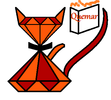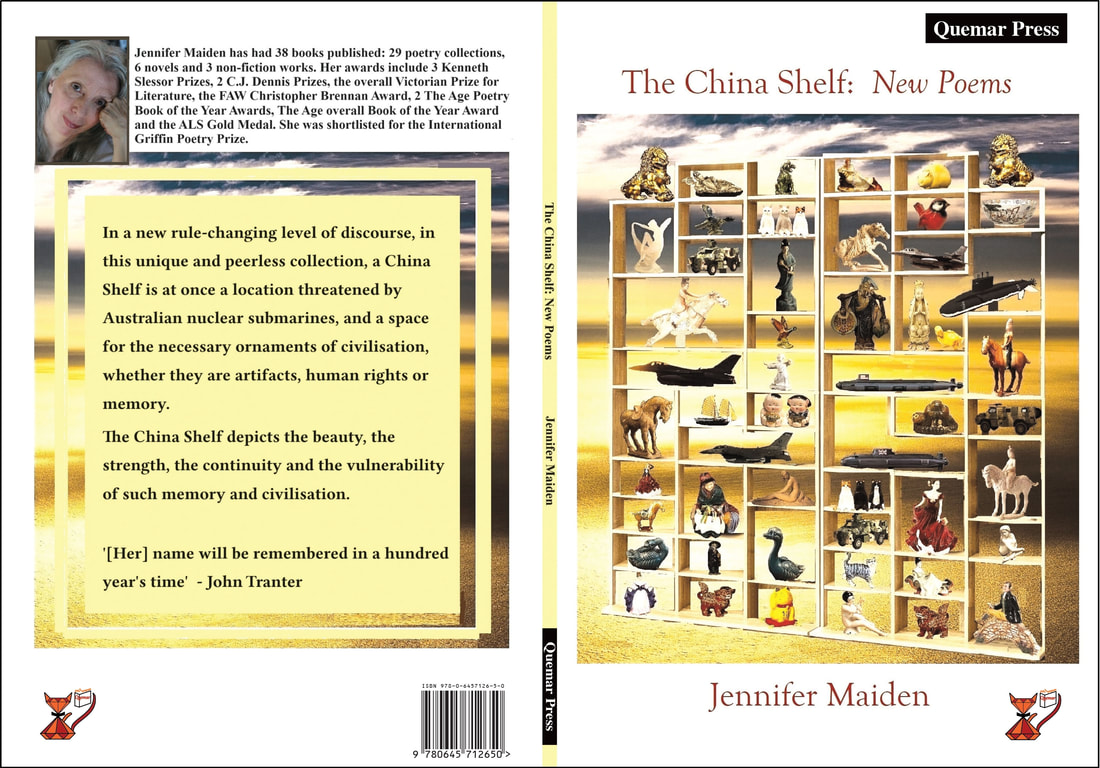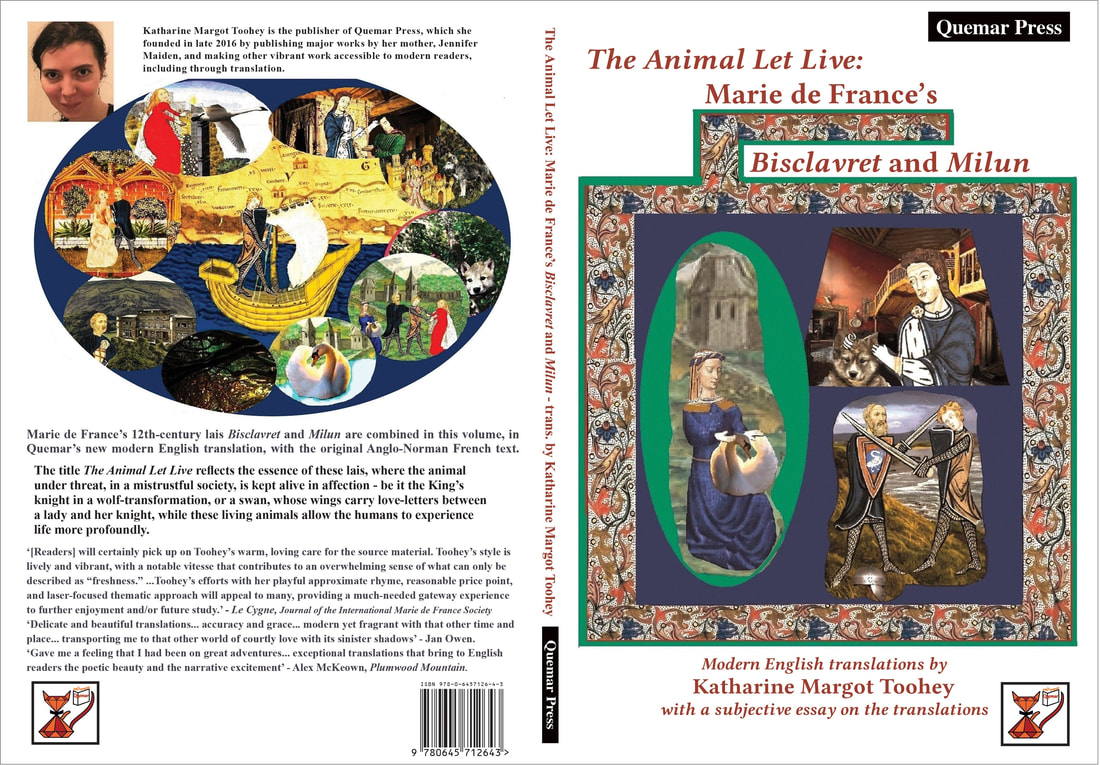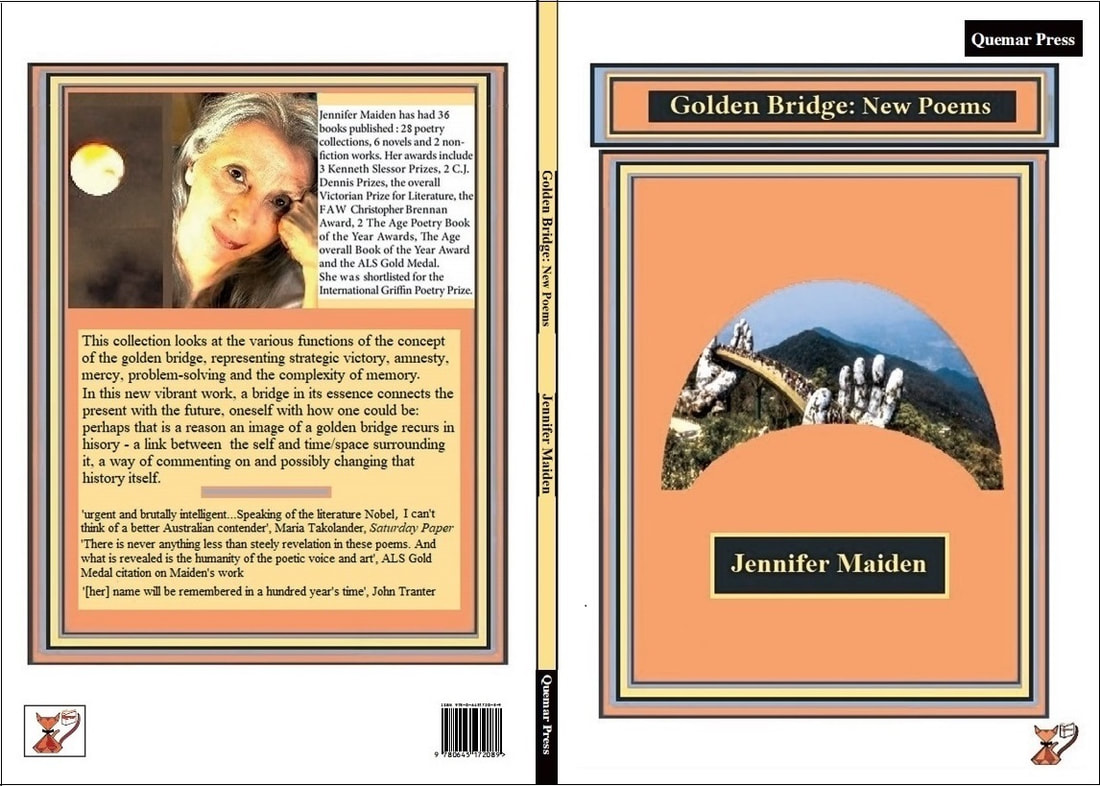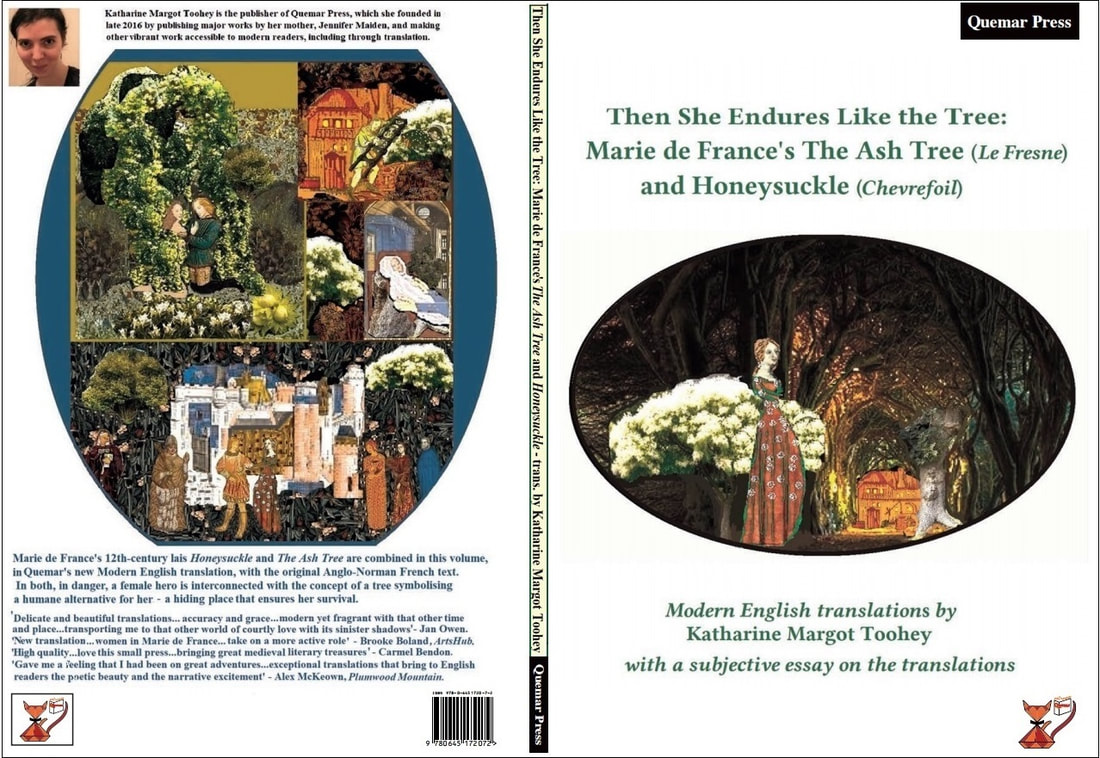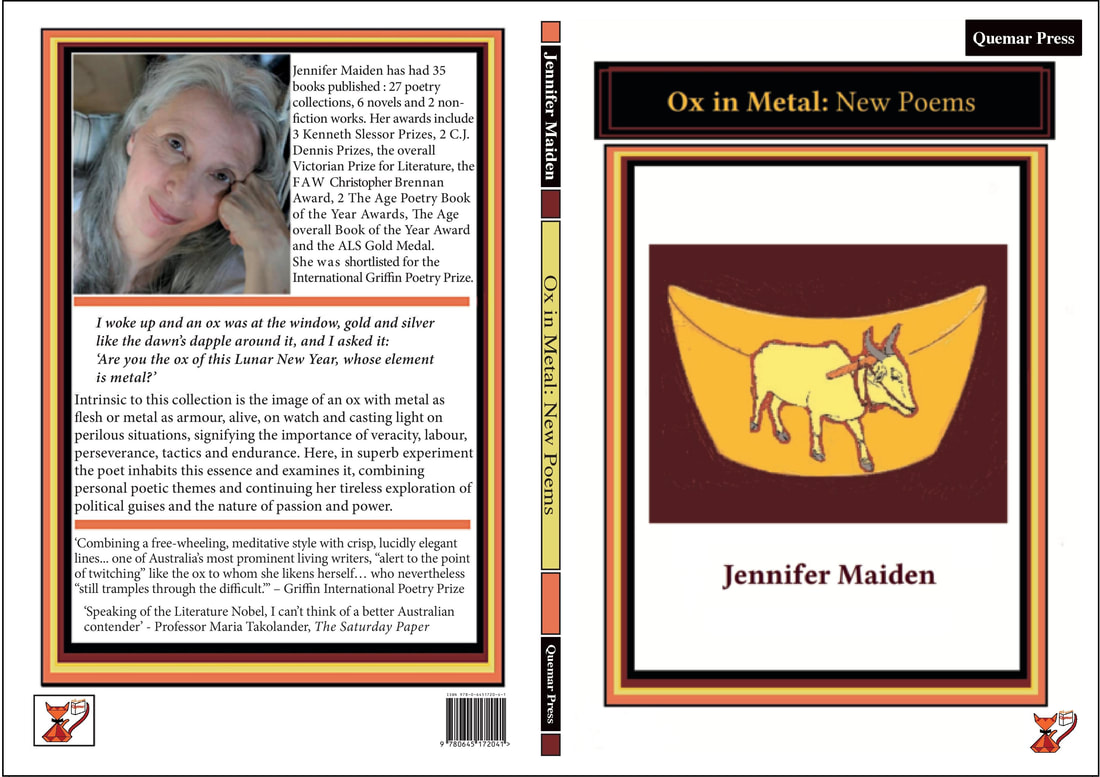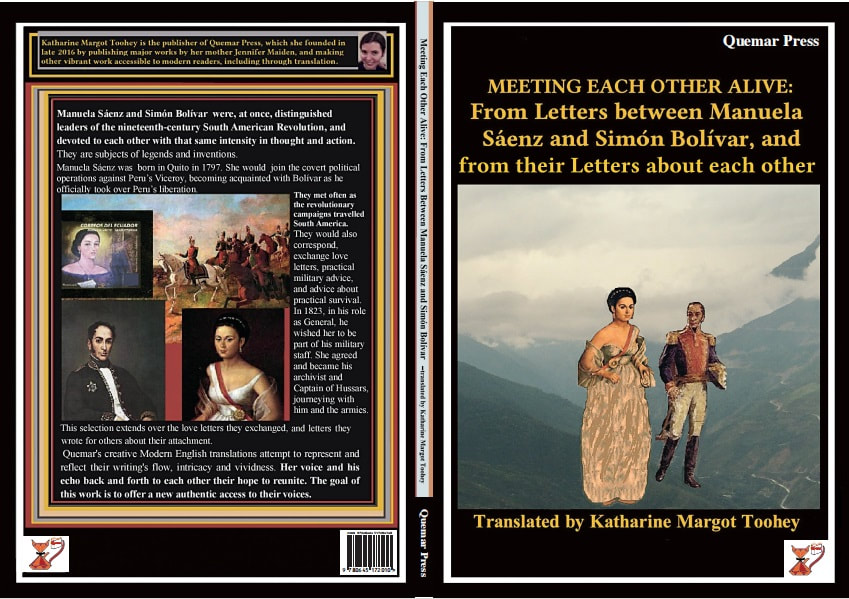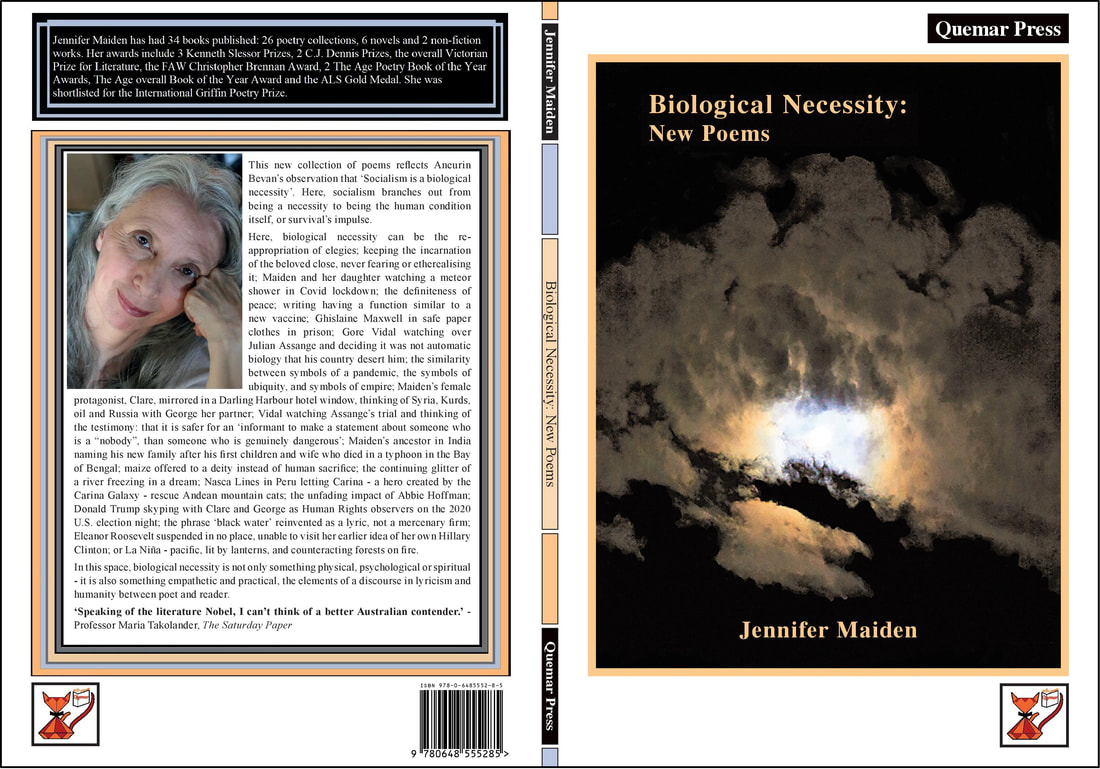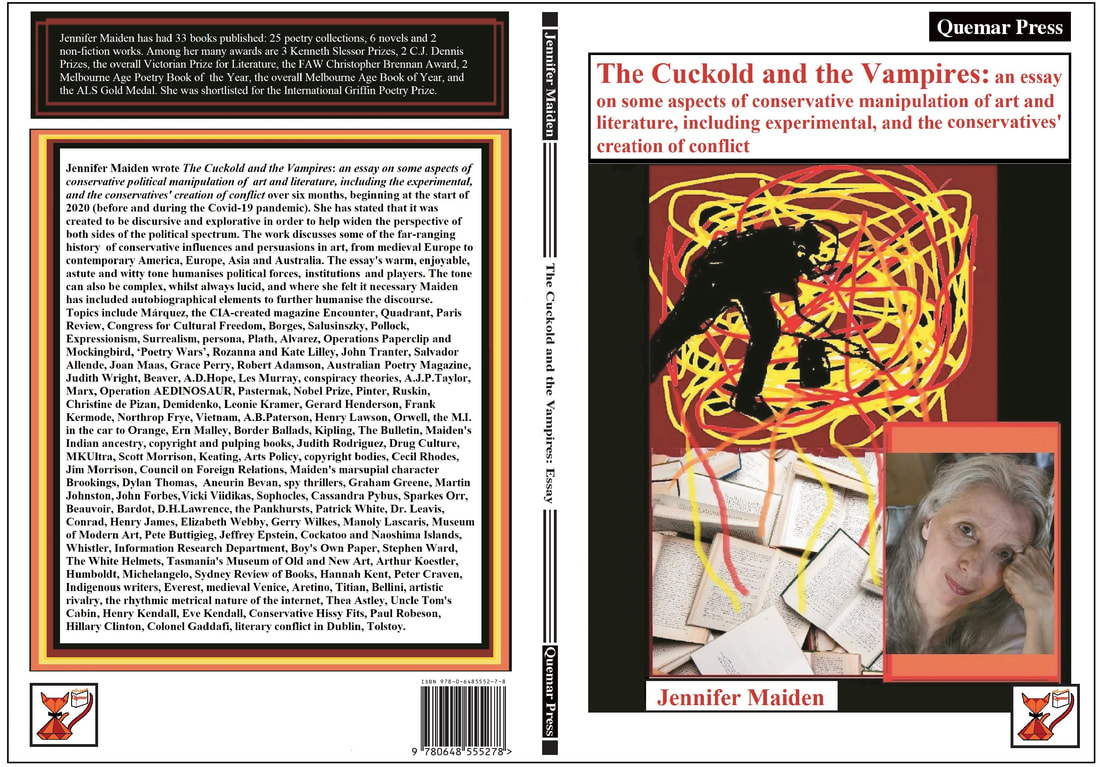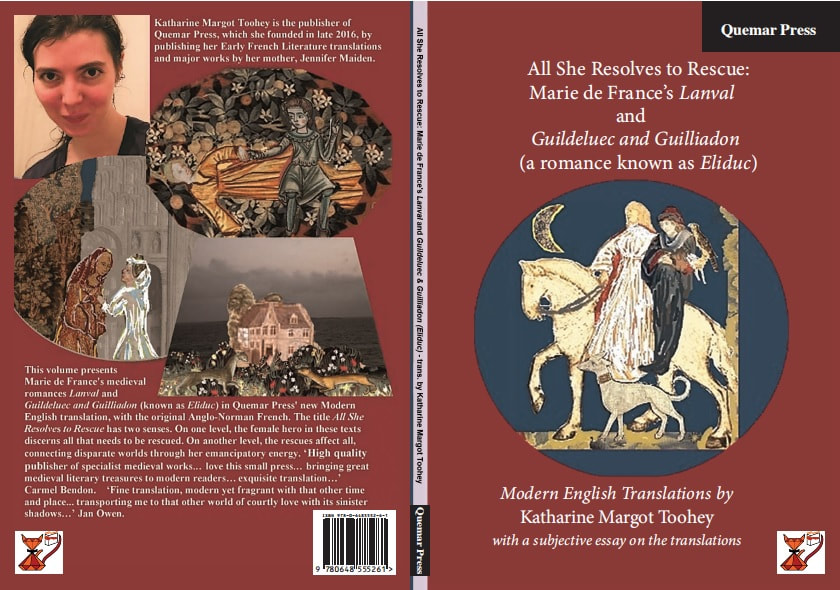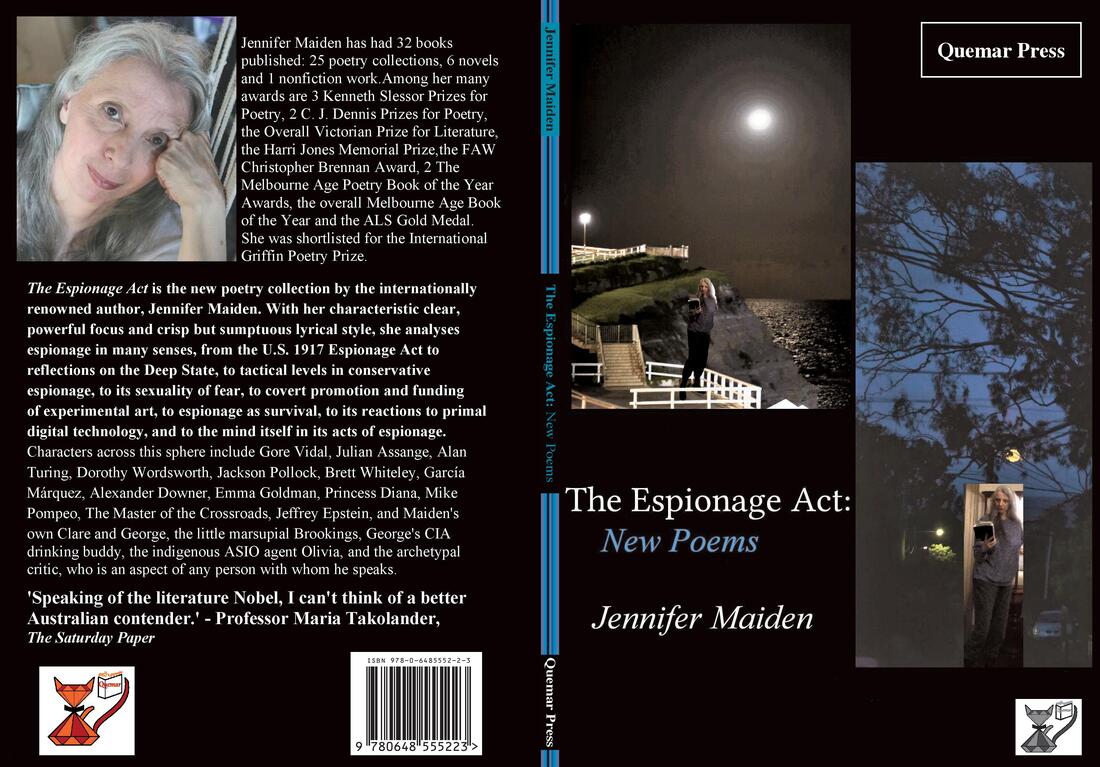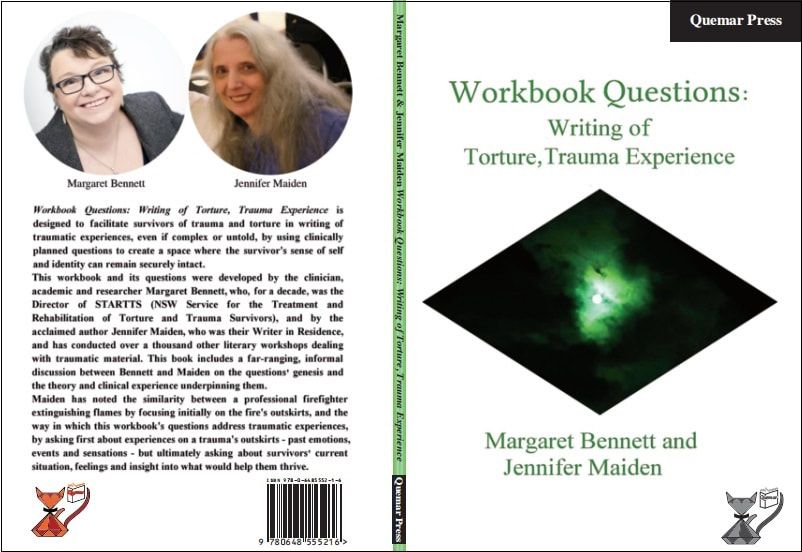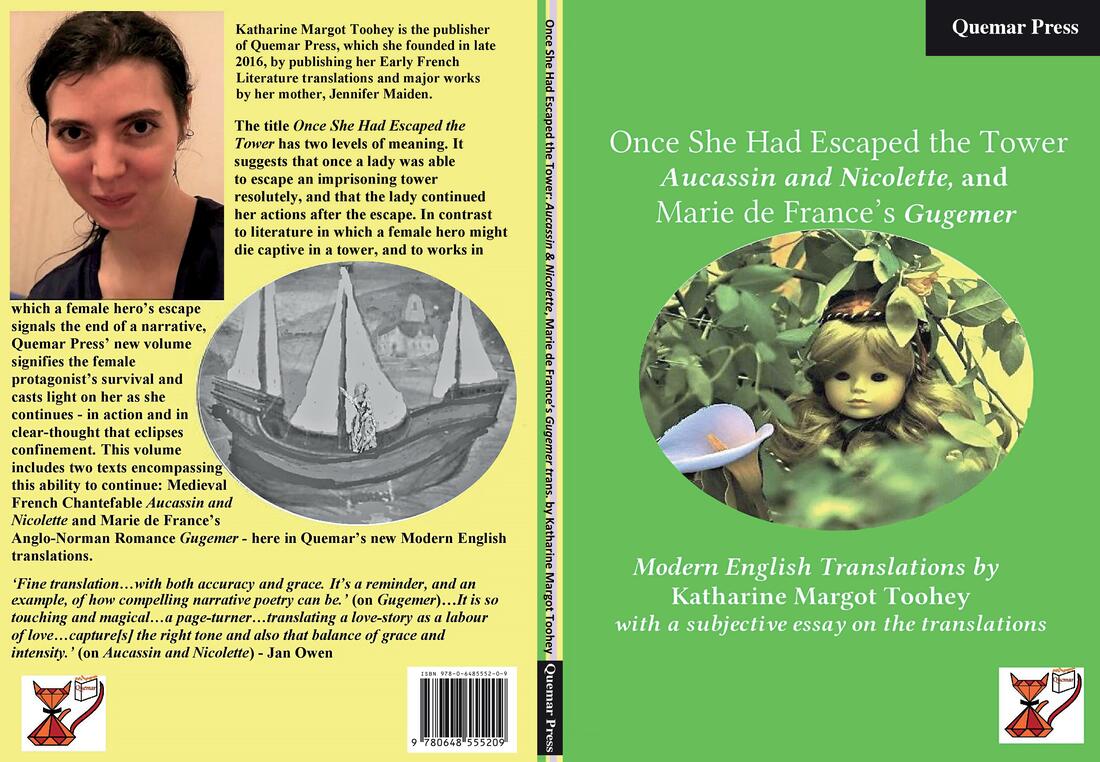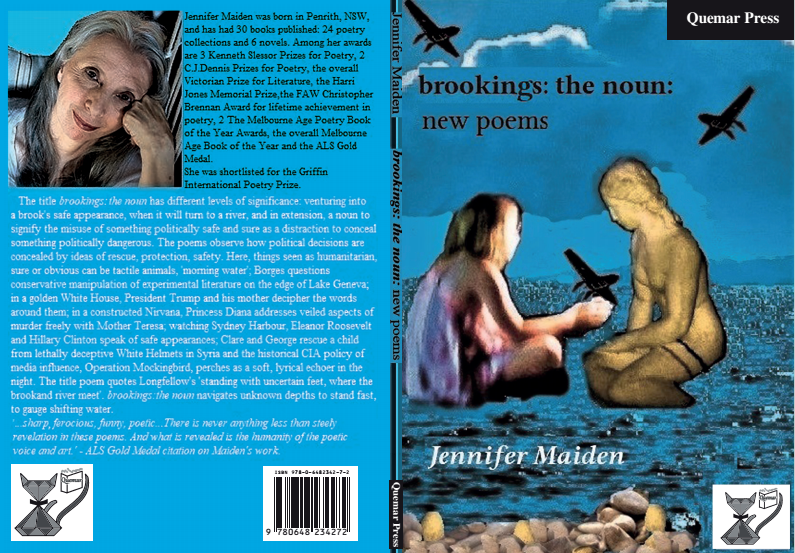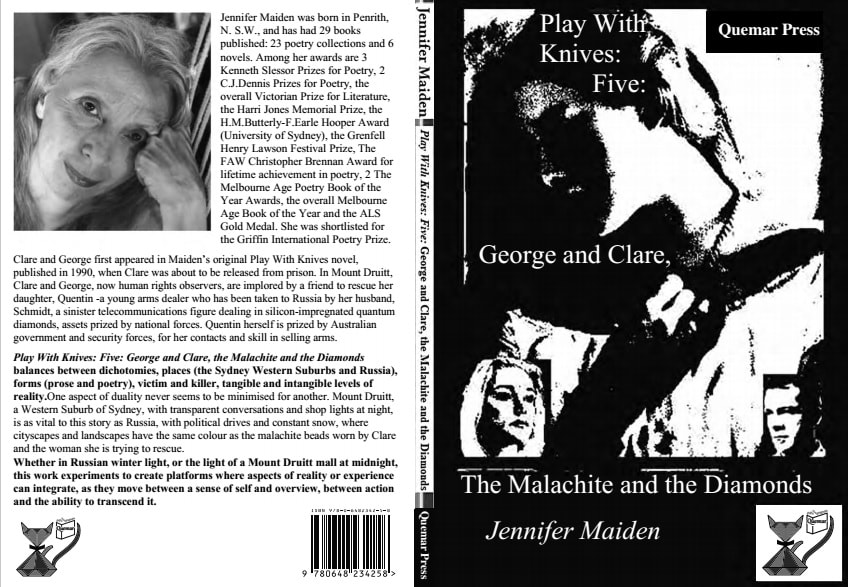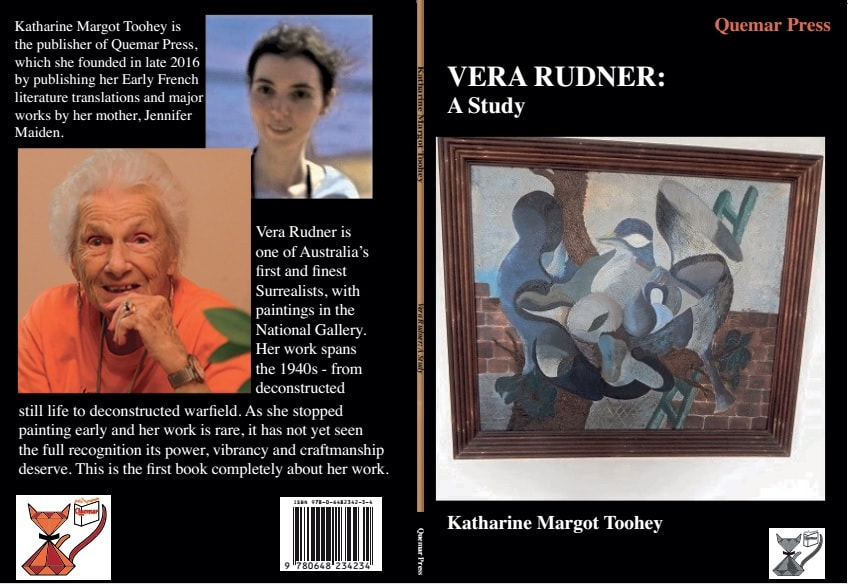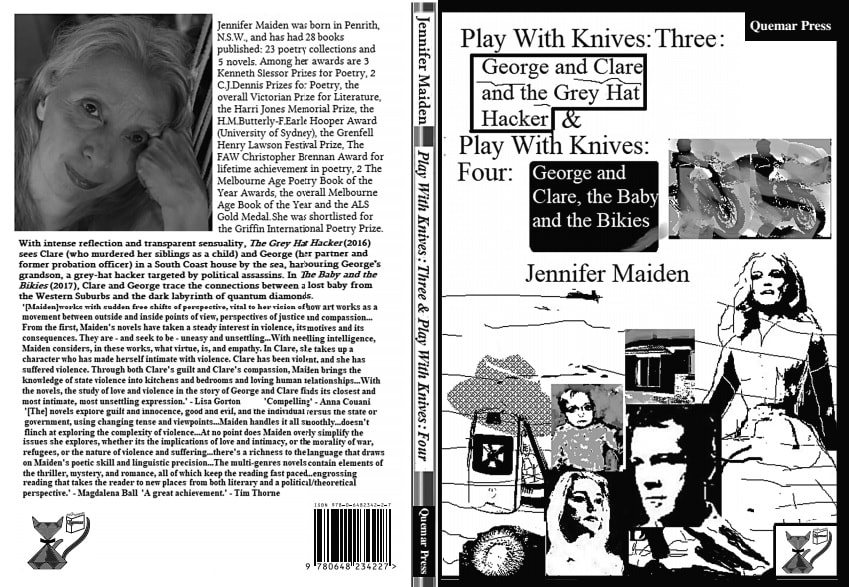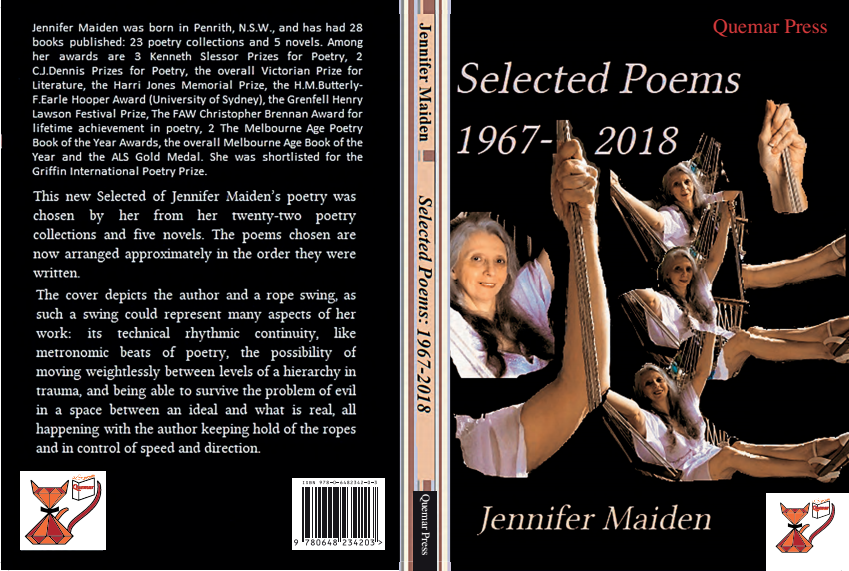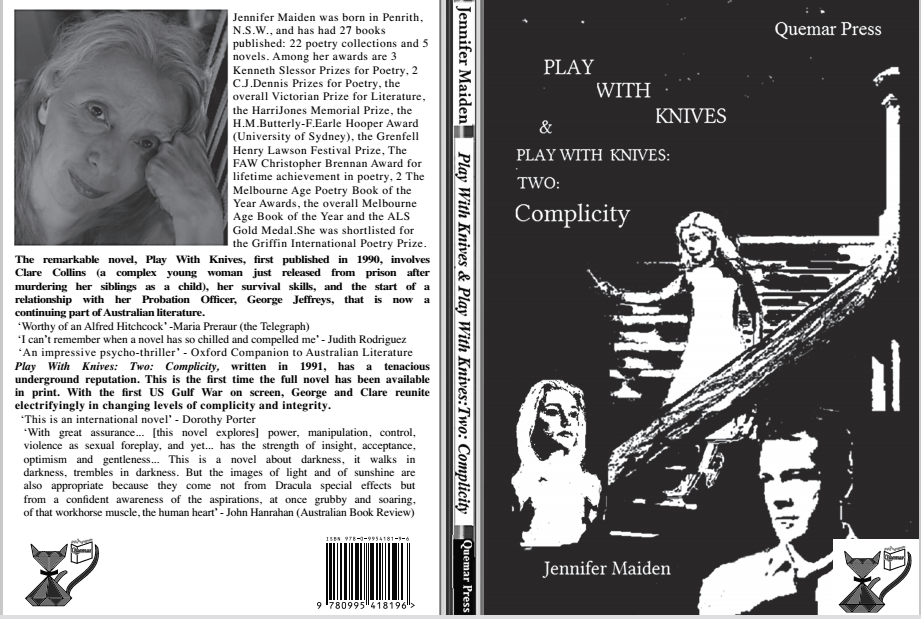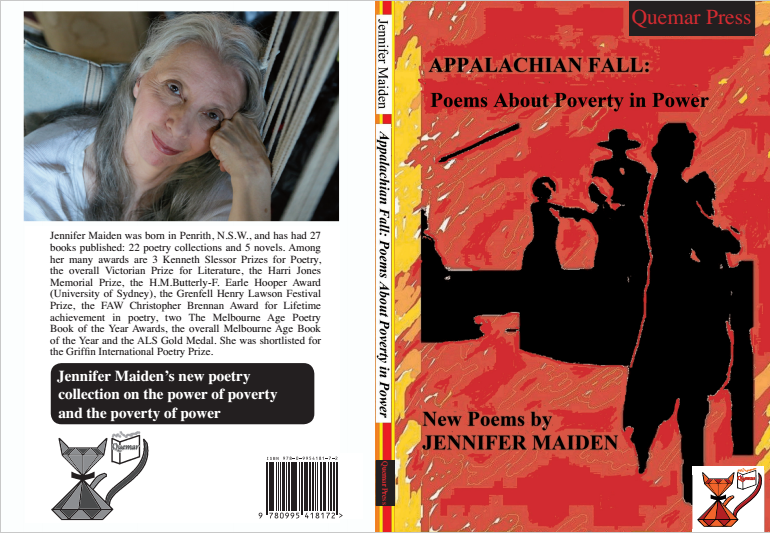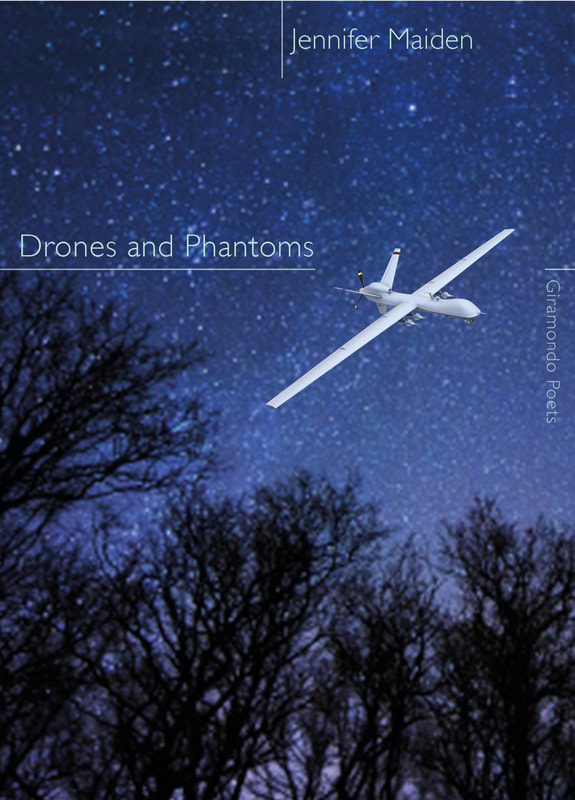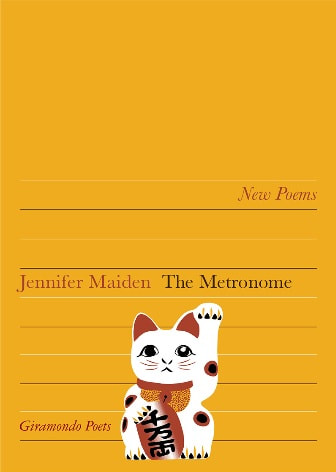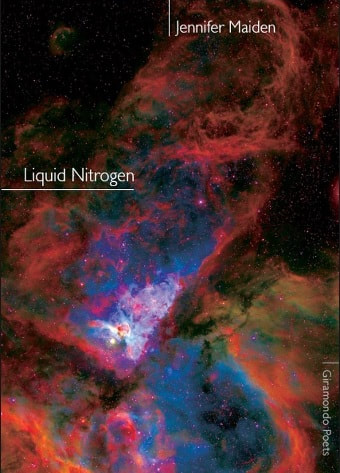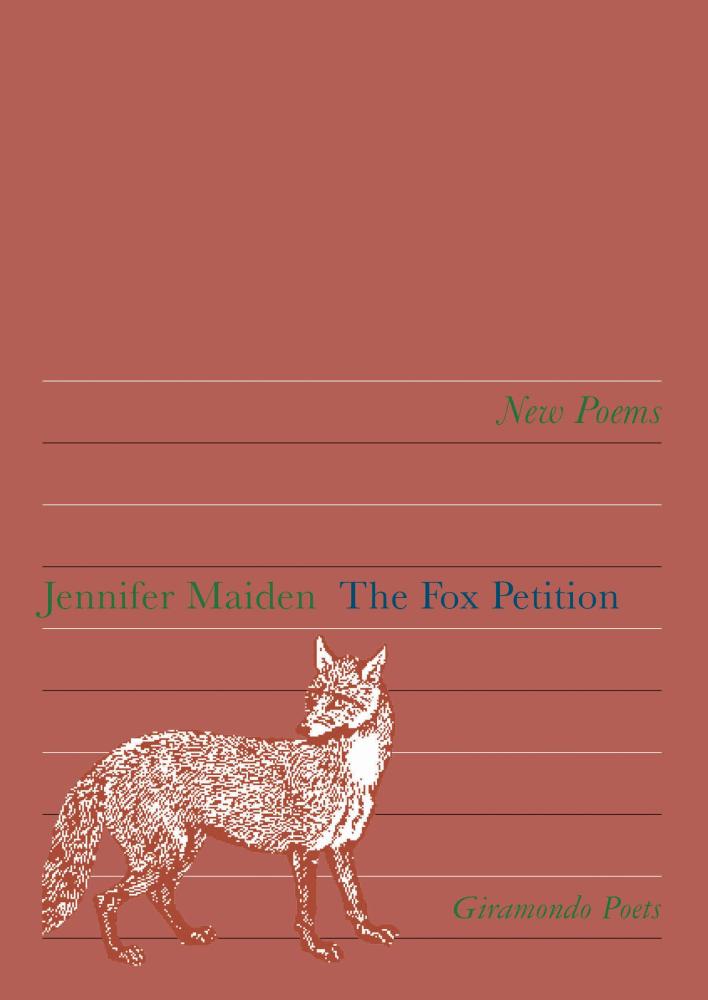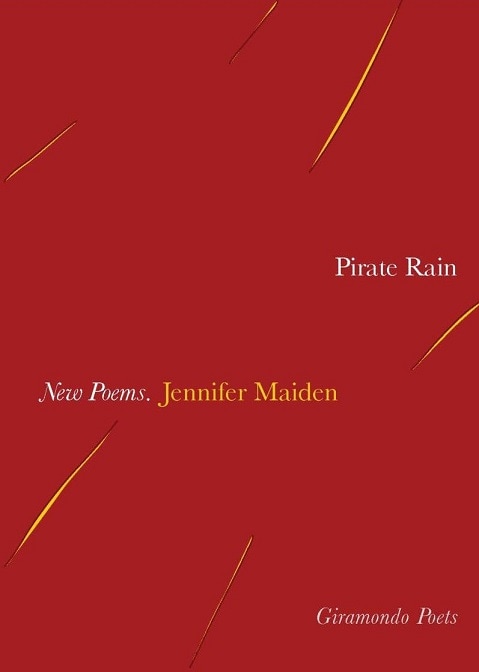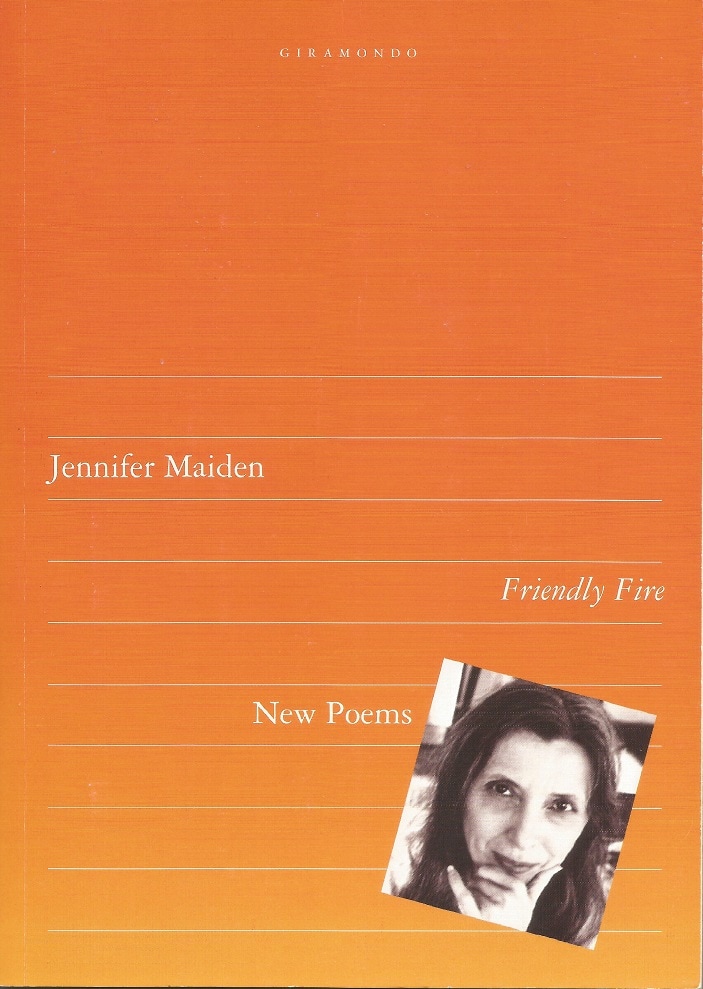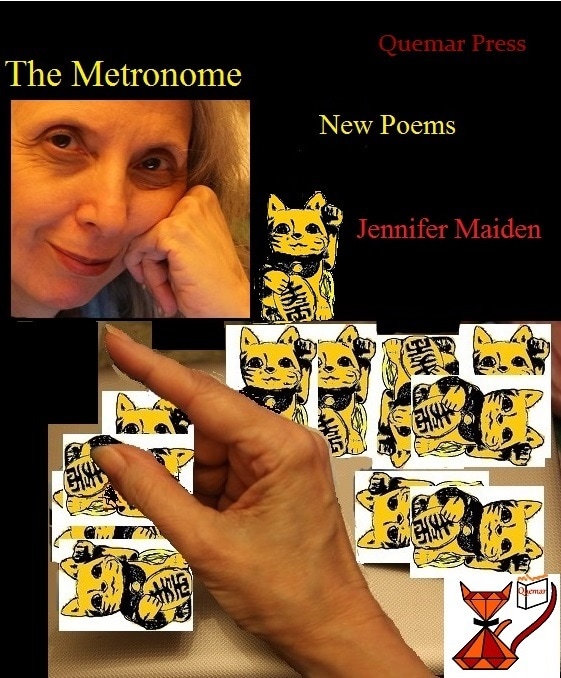Stockists
As well as being available for purchase below, Quemar Press titles are also available from the following bookstores:
Gleebooks
Abbey's Bookshop
Better Read Than Dead Bookshop
Imprints Booksellers
MacLean's Booksellers
Andrew's Bookshop
Readings
Resistance Books
Kris Hemensley's not-a-shop (formerly Collected Works)
Kris explains, 'Melbourne friends can always try Kris Hemensley at the post-Collected Works not-a-shop'. He can be contacted by email at [email protected] or by the Collected Works Facebook page at:
https://www.facebook.com/pages/category/Bookstore/Collected-Works-Bookshop-175023895845165/
As well as being available for purchase below, Quemar Press titles are also available from the following bookstores:
Gleebooks
Abbey's Bookshop
Better Read Than Dead Bookshop
Imprints Booksellers
MacLean's Booksellers
Andrew's Bookshop
Readings
Resistance Books
Kris Hemensley's not-a-shop (formerly Collected Works)
Kris explains, 'Melbourne friends can always try Kris Hemensley at the post-Collected Works not-a-shop'. He can be contacted by email at [email protected] or by the Collected Works Facebook page at:
https://www.facebook.com/pages/category/Bookstore/Collected-Works-Bookshop-175023895845165/
Available for purchase on this page
(Everything on this page can be purchased via PayPal, whether or not you have a PayPal account. Alternatively, you can purchase from Quemar Press with a cheque or a money transfer - if you would like to purchase with one of these alternate methods, please contact Quemar using the form on the 'Contact' page. We post books through Australia Post mail as soon as the order is placed, and they have always been received very promptly.)
Books
The Animal Let Live : Marie de France's Bisclavret and Milun - Translated by
Katharine Margot Toohey
Then She Endures Like the Tree: Marie de France's The Ash Tree (Le Fresne) and
Honeysuckle (Chevrefoil) - Translated by Katharine Margot Toohey
Meeting Each Other Alive: From Letters between Manuela Sáenz and Simón Bolívar, and from their Letters about each other - Translated by Katharine Margot Toohey
All She Resolves to Rescue: Marie de France's Lanval and Guildeluec and Guilliadon (a romance known as Eliduc) - Modern English Translations by Katharine Margot Toohey (Quemar Press paperback)
Workbook Questions: Writing of Torture, Trauma Experience - Margaret Bennett and
Jennifer Maiden (Quemar Press paperback)
Once She Had Escaped the Tower: Aucassin and Nicolette and Marie de France's
Gugemer - Modern English Translations by Katharine Margot Toohey (Quemar Press paperback)
Vera Rudner: A Study - Katharine Margot Toohey (Quemar Press paperback)
Books by Jennifer Maiden:
The China Shelf: New Poems (Quemar Press paperback and electronic editions)
Golden Bridge (Quemar Press paperback and electronic editions)
Ox in Metal: New Poems (Quemar Press paperback and electronic editions)
Biological Necessity: New Poems (Quemar Press paperback and electronic editions)
The Cuckold and the Vampires: an essay on some aspects of conservative political
manipulation of art and literature, including the experimental, and the conservatives' creation of conflict (Quemar Press paperback)
The Espionage Act: New Poems (Quemar Press paperback and electronic editions)
brookings: the noun (Quemar Press paperback and electronic editions)
Play With Knives: Five (Quemar Press paperback and electronic editions)
Play With Knives: Three & Play With Knives: Four (Quemar Press paperback)
Selected Poems 1967-2018 (Quemar Press paperback & electronic editions)
Play With Knives and Play With Knives: Two: Complicity (Quemar Press paperback)
Appalachian Fall: Poems About Poverty in Power (Quemar Press paperback & electronic editions)
Drones and Phantoms (PDF file, electronic scan of Giramondo edition)
The Metronome (Giramondo paperback edition)
Liquid Nitrogen (Giramondo paperback edition)
The Fox Petition (Giramondo paperback edition)
Pirate Rain (Giramondo paperback edition)
Friendly Fire (PDF file, electronic scan of Giramondo paperback edition)
The Metronome (Quemar Press electronic edition)
|
Paperback Edition Plus Electronic Edition $18.50 (Australian dollars: free postage world-wide) 64 pages (Paperback Edition ISBN: 978-0-6457126-5-0)
|
|
|
Electronic Edition $5.00 (Australian dollars) 64 pages (Electronic Edition ISBN: 978-0-6457126-6-7)
|
|
The China Shelf: New Poems - Jennifer Maiden's much-requested new collection - is in stock and can be purchased now.
An 11-poem sampler can be read by clicking on the book's cover image above.
From Quemar's Press Release:
In a new rule-changing level of discourse, in this unique and peerless collection, a China Shelf is at once a location threatened by Australian nuclear submarines, and a space for the necessary ornaments of civilisation, whether they are artifacts, human rights or memory. Here, this is a symbolic space also represented by the concept of a physical china shelf. The multifaceted artifacts on the China Shelf manifest throughout the poems. In one sense, they are described as physical objects on a shelf, able to be placed, touched, appreciated and analysed. On it, models of nuclear submarines and military vehicles are as accessible as its exquisite ornaments, relaxed Art Deco nudes, Chinese lions, Tang horses, figurines of Robert Burns and dancers in red tones created with gold, water-carrier or arched Chinese ships. In another sense, such objects have counterparts in the narratives, where actual sampan-prowed ships can protect Iran, or an infant hybrid bush animal plays at being a bush master military vehicle. Elements and shelf are always fluid. Its objects turn animate as the Chinese lions shimmer through Beijing light-shows to the Belt and Road Forum. In a further sense, the objects symbolise tangible aspects of memory:
Let’s say the china shelf in this poem represents
just the antique memory full of madeleines…
In contrast, on a profound level such objects also symbolise intangible memory:
Let us consider in the quietness of a poem
what is held on the soul's china shelf when
it boasts both ornament and artifice in the name
of memory, so that artificial intelligence is human
as it always was, always a matter of the mind
alternating stress and unstress to retain…
In keeping with Maiden’s description of the ornaments as ‘inherited or acquired manifestations of civilisation’, concepts of human rights are also on the China shelf. One poem imagines the late Australian writers Charmian Clift and Martin Johnston currently having a picnic at an ocean-cliff:
...before them on the checkered cloth, like
pieces of practical
china are the objects
of the Universal Declaration of Human Rights
as conceived by Eleanor Roosevelt, and they
comfort each other about the latest
terrors like the Siege of Gaza…
The shelf expands with figures of Imran Khan and Julian Assange, is also the shelf in Assange’s gaol cell, where the late Gore Vidal watches over his reader Assange. In 2023 New York, Eleanor Roosevelt eats from the shelf’s plates, considers the start of Empire and American Rules Based Order. In turn, the China Shelf branches out into midnight Chinese gardens where imagined Human Rights observers Clare Collins and George Jeffreys speak with Confucius, aid an ASIO-threatened Chinese Academic. In Vietnam and San Francisco, Albanese’s late mentor Tom Uren watches him concerned, compares his mind to a childhood china shelf. In this book, the elements of the china shelf have countless configurations. The China Shelf depicts the beauty, the strength, the continuity and the vulnerability of memory and civilisation.
'[Her] name will be remembered in a hundred year's time' - John Tranter
___________________________________________________________________________________________________________________________________________
An 11-poem sampler can be read by clicking on the book's cover image above.
From Quemar's Press Release:
In a new rule-changing level of discourse, in this unique and peerless collection, a China Shelf is at once a location threatened by Australian nuclear submarines, and a space for the necessary ornaments of civilisation, whether they are artifacts, human rights or memory. Here, this is a symbolic space also represented by the concept of a physical china shelf. The multifaceted artifacts on the China Shelf manifest throughout the poems. In one sense, they are described as physical objects on a shelf, able to be placed, touched, appreciated and analysed. On it, models of nuclear submarines and military vehicles are as accessible as its exquisite ornaments, relaxed Art Deco nudes, Chinese lions, Tang horses, figurines of Robert Burns and dancers in red tones created with gold, water-carrier or arched Chinese ships. In another sense, such objects have counterparts in the narratives, where actual sampan-prowed ships can protect Iran, or an infant hybrid bush animal plays at being a bush master military vehicle. Elements and shelf are always fluid. Its objects turn animate as the Chinese lions shimmer through Beijing light-shows to the Belt and Road Forum. In a further sense, the objects symbolise tangible aspects of memory:
Let’s say the china shelf in this poem represents
just the antique memory full of madeleines…
In contrast, on a profound level such objects also symbolise intangible memory:
Let us consider in the quietness of a poem
what is held on the soul's china shelf when
it boasts both ornament and artifice in the name
of memory, so that artificial intelligence is human
as it always was, always a matter of the mind
alternating stress and unstress to retain…
In keeping with Maiden’s description of the ornaments as ‘inherited or acquired manifestations of civilisation’, concepts of human rights are also on the China shelf. One poem imagines the late Australian writers Charmian Clift and Martin Johnston currently having a picnic at an ocean-cliff:
...before them on the checkered cloth, like
pieces of practical
china are the objects
of the Universal Declaration of Human Rights
as conceived by Eleanor Roosevelt, and they
comfort each other about the latest
terrors like the Siege of Gaza…
The shelf expands with figures of Imran Khan and Julian Assange, is also the shelf in Assange’s gaol cell, where the late Gore Vidal watches over his reader Assange. In 2023 New York, Eleanor Roosevelt eats from the shelf’s plates, considers the start of Empire and American Rules Based Order. In turn, the China Shelf branches out into midnight Chinese gardens where imagined Human Rights observers Clare Collins and George Jeffreys speak with Confucius, aid an ASIO-threatened Chinese Academic. In Vietnam and San Francisco, Albanese’s late mentor Tom Uren watches him concerned, compares his mind to a childhood china shelf. In this book, the elements of the china shelf have countless configurations. The China Shelf depicts the beauty, the strength, the continuity and the vulnerability of memory and civilisation.
'[Her] name will be remembered in a hundred year's time' - John Tranter
___________________________________________________________________________________________________________________________________________
|
The Animal Let Live (Quemar Press paperback) $18.50 (Australian dollars), free postage worldwide. 72 pages (Paperback ISBN: 978-0-6457126-4-3)
|
|
The Animal Let Live: Marie de France’s Bisclavret and Milun - Quemar's new paperback - is available now
From Quemar's Press' Release:
Marie de France's 12th-century lais Bisclavret and Milun are combined in this volume, in Quemar's new Modern English translation, with the original Anglo-Norman French text.
The title The Animal Let Live reflects the essence of these lais, where the animal under threat, in a mistrustful society, is kept alive in affection - be it a knight suspended in a wolf-transformation, or a swan, whose wings carry every utterance in secret from a lady and knight in love but severed from each other. These living animals, in turn, allow the humans to experience life in more profound levels of emotion.
Marie de France, considered to be the earliest female French poet, constructed these lais from ancient Breton lais, originally translating them in the twelfth-century to Anglo-Norman French. While Quemar's Modern English translation is of all the original Anglo-Norman text, this is also included, juxtaposed with the translation.
Bisclavret is a re-imagining by Marie de France of traditional werewolf legends. Here, the werewolf-knight is identical to an engaging and non-threatening wolf - similar to a wolf-cub. He is suspended in wolf-guise after his spouse had his clothes stolen to prevent him from turning into a knight again, leaving him forced to traverse the forest. There, the king is stunned at encountering this animal with a man's reason and feels incapable of killing him in a hunt.
In Milun, a Lady and the knight Milun fell in love and had a son in secret. Under the threat of retribution and dishonour, she sent this child to live guarded by her sister in Northumbria, sending with him a ring and a letter for him when he is an adult, to let him find his father. Unaware, the lady's father gives her away in marriage to a Baron. The lady and Milun live in love - speaking only by messages hidden in a swan's plumes. Never to be food, the swan has been nourished and cherished as a pet by the knight. It is their messenger for twenty years, as they hope to meet together again.
In other literature, purification may be reached in recoil from the death of a hunted animal - just as the slain albatross haunts Coleridge's The Ancient Mariner, or the murdered ethereal deer transforms Marie's own Gugemer. But in Bisclavret the knight in living wolf form gives the King a new level of mercy:
This beast has understanding and reason.
Act now; light us on.
To the beast I grant rest,
for I'll hunt no more this forest.'
In Bisclavret and Milun the animal remaining alive leads to the narrative's resolution.Within these texts, the animals grant new elements to the lives of those around them - whether that be the King's love, in wonder at the mysterious and beautiful animal from the forest, or every word between the lady and the knight, lost if not for a swan's living wings.
'[Readers] will certainly pick up on Toohey’s warm, loving care for the source material. Toohey’s style is lively and vibrant, with a notable vitesse that contributes to an overwhelming sense of what can only be described as "freshness."...Toohey’s efforts with her playful approximate rhyme, reasonable price point, and laser-focused thematic approach will appeal to many, providing a much-needed gateway experience to further enjoyment and/or future study.' - Le Cygne, Journal of the International Marie de France Society.
‘Delicate and beautiful translations…accuracy and grace...modern yet fragrant with that other time and place…transporting me to that other world of courtly love with its sinister shadows’ - Jan Owen.‘Gave me a feeling that I had been on great adventures…exceptional translations that bring to English readers the poetic beauty and the narrative excitement' - Alex McKeown, Plumwood Mountain.
___________________________________________________________________________________________________________________________________________
From Quemar's Press' Release:
Marie de France's 12th-century lais Bisclavret and Milun are combined in this volume, in Quemar's new Modern English translation, with the original Anglo-Norman French text.
The title The Animal Let Live reflects the essence of these lais, where the animal under threat, in a mistrustful society, is kept alive in affection - be it a knight suspended in a wolf-transformation, or a swan, whose wings carry every utterance in secret from a lady and knight in love but severed from each other. These living animals, in turn, allow the humans to experience life in more profound levels of emotion.
Marie de France, considered to be the earliest female French poet, constructed these lais from ancient Breton lais, originally translating them in the twelfth-century to Anglo-Norman French. While Quemar's Modern English translation is of all the original Anglo-Norman text, this is also included, juxtaposed with the translation.
Bisclavret is a re-imagining by Marie de France of traditional werewolf legends. Here, the werewolf-knight is identical to an engaging and non-threatening wolf - similar to a wolf-cub. He is suspended in wolf-guise after his spouse had his clothes stolen to prevent him from turning into a knight again, leaving him forced to traverse the forest. There, the king is stunned at encountering this animal with a man's reason and feels incapable of killing him in a hunt.
In Milun, a Lady and the knight Milun fell in love and had a son in secret. Under the threat of retribution and dishonour, she sent this child to live guarded by her sister in Northumbria, sending with him a ring and a letter for him when he is an adult, to let him find his father. Unaware, the lady's father gives her away in marriage to a Baron. The lady and Milun live in love - speaking only by messages hidden in a swan's plumes. Never to be food, the swan has been nourished and cherished as a pet by the knight. It is their messenger for twenty years, as they hope to meet together again.
In other literature, purification may be reached in recoil from the death of a hunted animal - just as the slain albatross haunts Coleridge's The Ancient Mariner, or the murdered ethereal deer transforms Marie's own Gugemer. But in Bisclavret the knight in living wolf form gives the King a new level of mercy:
This beast has understanding and reason.
Act now; light us on.
To the beast I grant rest,
for I'll hunt no more this forest.'
In Bisclavret and Milun the animal remaining alive leads to the narrative's resolution.Within these texts, the animals grant new elements to the lives of those around them - whether that be the King's love, in wonder at the mysterious and beautiful animal from the forest, or every word between the lady and the knight, lost if not for a swan's living wings.
'[Readers] will certainly pick up on Toohey’s warm, loving care for the source material. Toohey’s style is lively and vibrant, with a notable vitesse that contributes to an overwhelming sense of what can only be described as "freshness."...Toohey’s efforts with her playful approximate rhyme, reasonable price point, and laser-focused thematic approach will appeal to many, providing a much-needed gateway experience to further enjoyment and/or future study.' - Le Cygne, Journal of the International Marie de France Society.
‘Delicate and beautiful translations…accuracy and grace...modern yet fragrant with that other time and place…transporting me to that other world of courtly love with its sinister shadows’ - Jan Owen.‘Gave me a feeling that I had been on great adventures…exceptional translations that bring to English readers the poetic beauty and the narrative excitement' - Alex McKeown, Plumwood Mountain.
___________________________________________________________________________________________________________________________________________
|
Paperback Edition Plus Electronic Edition $18.50 (Australian dollars: free postage world-wide) 64 pages (Paperback Edition ISBN: 978-0-6451720-8-9)
|
|
|
Electronic Edition $5.00 (Australian dollars) 64 pages (Electronic Edition ISBN: 978-0-6451720-9-6)
|
|
Golden Bridge - Jennifer Maiden's new poetry collection from Quemar Press - is available now.
An eleven-poem Sampler can be read by clicking on the cover above.
From Quemar's Press Release:
This collection looks at the various functions of the concept and reality of the golden bridge, representing strategic victory, amnesty, mercy, problem-solving and the complexity of memory.
In this vibrant new work, a bridge in its essence connects the present with the future, oneself with how one could be: perhaps that is a reason the image of a golden bridge reoccurs in history - a link between the self and time/space surrounding it, a way of commenting on and possibly changing that history itself. In the world, ideas of a 'bridge in gold' seem to occur often. General Kutuzov described his exit strategy for the invading French army as a 'golden bridge'.
'Kutuzov would have hands like that:
gnarled and bleached by age and earth, to hold
his bridge in a grip both loose, reverential and solid.'
In Vietnam, there is a bridge named Cầu Vàng (golden bridge), supported by vast stone hands, just as a bridge in gold colour connects islands in Bali. Perhaps the bridge often has golden hues to represent auspiciousness, wealth, or a wealth of mercy.
These poems reflect a golden bridge and this image ripples and mirrors through the poems' changing fathoms. Here a bridge in gold is that of a Chinese garden with light cast upon it, just as it is Kutuzov's strategy, the curve of a moon in eclipse, the artist's pen outlining a new moral compass for someone, the arched moon being witness as someone plans intricately but delays rescue, Bali's expansive bridge watched by Albanese and Tom Uren as Uren fears for Assange, the crescent of a sleeping cat, the shape of an entity carrying another in its arms, the truck-bombed Kerch Bridge at dawn, the arc of a twisting golden Chinese dragon, or ultimately:
'a golden bridge from Time to Time, with health being
a temporal velocity, as Time increases its strength
by disconnecting from itself, like a disappearing dragon
returning from cloud paradise with cloudy incarnation.'
'urgent and brutally intelligent… Speaking of the literature Nobel, I can’t think of a better Australian contender.' - Professor Maria Takolander, The Saturday Paper
'There is never anything less than steely revelation in these poems. And what is revealed is the humanity of the poetic voice and art' - ALS Gold Medal citation
'[her] name will be remembered in a hundred year's time' - John Tranter
__________________________________________________________________________________________________________________________________________
An eleven-poem Sampler can be read by clicking on the cover above.
From Quemar's Press Release:
This collection looks at the various functions of the concept and reality of the golden bridge, representing strategic victory, amnesty, mercy, problem-solving and the complexity of memory.
In this vibrant new work, a bridge in its essence connects the present with the future, oneself with how one could be: perhaps that is a reason the image of a golden bridge reoccurs in history - a link between the self and time/space surrounding it, a way of commenting on and possibly changing that history itself. In the world, ideas of a 'bridge in gold' seem to occur often. General Kutuzov described his exit strategy for the invading French army as a 'golden bridge'.
'Kutuzov would have hands like that:
gnarled and bleached by age and earth, to hold
his bridge in a grip both loose, reverential and solid.'
In Vietnam, there is a bridge named Cầu Vàng (golden bridge), supported by vast stone hands, just as a bridge in gold colour connects islands in Bali. Perhaps the bridge often has golden hues to represent auspiciousness, wealth, or a wealth of mercy.
These poems reflect a golden bridge and this image ripples and mirrors through the poems' changing fathoms. Here a bridge in gold is that of a Chinese garden with light cast upon it, just as it is Kutuzov's strategy, the curve of a moon in eclipse, the artist's pen outlining a new moral compass for someone, the arched moon being witness as someone plans intricately but delays rescue, Bali's expansive bridge watched by Albanese and Tom Uren as Uren fears for Assange, the crescent of a sleeping cat, the shape of an entity carrying another in its arms, the truck-bombed Kerch Bridge at dawn, the arc of a twisting golden Chinese dragon, or ultimately:
'a golden bridge from Time to Time, with health being
a temporal velocity, as Time increases its strength
by disconnecting from itself, like a disappearing dragon
returning from cloud paradise with cloudy incarnation.'
'urgent and brutally intelligent… Speaking of the literature Nobel, I can’t think of a better Australian contender.' - Professor Maria Takolander, The Saturday Paper
'There is never anything less than steely revelation in these poems. And what is revealed is the humanity of the poetic voice and art' - ALS Gold Medal citation
'[her] name will be remembered in a hundred year's time' - John Tranter
__________________________________________________________________________________________________________________________________________
|
Then She Endures Like the Tree (Quemar Press paperback) $17.00 (Australian dollars), free postage worldwide. 64 pages (Paperback ISBN: 978-0-6451720-7-2)
|
|
Then She Endures Like the Tree: Marie de France’s The Ash Tree (Le Fresne) and Honeysuckle (Chevrefoil) - Quemar Press' new paperback - is available now
From Quemar's Press Release:
Marie de France's 12th-century lais Honeysuckle and The Ash Tree are combined in this volume, in Quemar's new Modern English translation, with the original Anglo-Norman French text.
In both, in danger, a female hero is interconnected with the concept of a tree symbolising a humane alternative for her - a hiding place that ensures her survival. In literature and legend, a female hero sometimes transforms into a tree to remedy a problem, just as Daphne metamorphoses into a laurel tree, guarded against Apollo, or Barbara Allen's spirit is preserved in the briar that springs from her grave. In contrast, in Marie de France's The Ash Tree and Honeysuckle, the female heroes remain human and incarnate and take on aspects of a tree that shelters them. In these works, the metaphoric tree symbolising them is also something with which they can interact physically - branches that protected Fresne (The Ash Tree's hero) in darkness or a subversive forest that becomes a sanctuary for the Queen Iseult and her beloved in exile, the knight Tristan. This metaphor is made tangible and practical in the narrative.
The Romance The Ash Tree is named after the female hero, Fresne - given the name of the Ash Tree, as she was resting in its branches when she was found as a newborn. Her mother, having borne twins, feared for her own reputation. She had slandered her neighbour's fidelity by suggesting that it was not possible to give birth to twins without being promiscuous. Her mother agreed that Fresne be left at a minster, where her gentlewoman prayed and chose to leave her at the Ash Tree:
'In her arms, she took the baby
and she ran to the ash tree,
set her there and left her there,
in truth to God entrusted her.'
The branching Ash protects the child from danger, steadfast through night, secrecy, danger or abandonment. In this lai, spontaneous affection overcomes conceptual rejection. Here, the female hero does not wish suffering or punishment for a woman who abandoned her. This is a story where the woman's individuality, reality and being are powerful catalysts driving the plot, and remorse is far out-weighed by joy at having found at last the woman lost.
Honeysuckle (Chevrefoil), seems to re-imagine the traditional tragic Romance of Iseult and Tristan, in a chosen catalytic space - deep in a forest where the heroes interlink in communication and affection: just as, Marie writes, the honeysuckle vine entwines with hazel. The forest is a sanctuary or hiding place for the Queen Iseult and for Tristan, who has been exiled because of his love for her by the King, his uncle.
With layers of intertextuality, the text seems to suggest that intervention is possible - a refuge away from exile, moments of speaking together in forest depths that could lead to resolution.
While Quemar's translations are of all the original text, the original is included for appreciation and interest, juxtaposed with the translation. To mirror its fast pace and cadence, Quemar's creative Modern English translation tries to retain the original four stresses to a line, minimal punctuation and driving final rhyme.
These works let the truth in metaphor and the truth in reality be juxtaposed, allow new ways of perceiving the narrative's universe and the female hero - who is as enduring as any branch that encircles its own.
‘Delicate and beautiful translations…accuracy and grace...modern yet fragrant with that other time and place…transporting me to that other world of courtly love with its sinister shadows’ - Jan Owen. ‘New translation...women in Marie de France... take on a more active role' - Brooke Boland, ArtsHub. 'High quality…love this small press....bringing great medieval literary treasures’ - Carmel Bendon. ‘Gave me a feeling that I had been on great adventures…exceptional translations that bring to English readers the poetic beauty and the narrative excitement' - Alex McKeown, Plumwood Mountain.
___________________________________________________________________________________________________________________________________________
From Quemar's Press Release:
Marie de France's 12th-century lais Honeysuckle and The Ash Tree are combined in this volume, in Quemar's new Modern English translation, with the original Anglo-Norman French text.
In both, in danger, a female hero is interconnected with the concept of a tree symbolising a humane alternative for her - a hiding place that ensures her survival. In literature and legend, a female hero sometimes transforms into a tree to remedy a problem, just as Daphne metamorphoses into a laurel tree, guarded against Apollo, or Barbara Allen's spirit is preserved in the briar that springs from her grave. In contrast, in Marie de France's The Ash Tree and Honeysuckle, the female heroes remain human and incarnate and take on aspects of a tree that shelters them. In these works, the metaphoric tree symbolising them is also something with which they can interact physically - branches that protected Fresne (The Ash Tree's hero) in darkness or a subversive forest that becomes a sanctuary for the Queen Iseult and her beloved in exile, the knight Tristan. This metaphor is made tangible and practical in the narrative.
The Romance The Ash Tree is named after the female hero, Fresne - given the name of the Ash Tree, as she was resting in its branches when she was found as a newborn. Her mother, having borne twins, feared for her own reputation. She had slandered her neighbour's fidelity by suggesting that it was not possible to give birth to twins without being promiscuous. Her mother agreed that Fresne be left at a minster, where her gentlewoman prayed and chose to leave her at the Ash Tree:
'In her arms, she took the baby
and she ran to the ash tree,
set her there and left her there,
in truth to God entrusted her.'
The branching Ash protects the child from danger, steadfast through night, secrecy, danger or abandonment. In this lai, spontaneous affection overcomes conceptual rejection. Here, the female hero does not wish suffering or punishment for a woman who abandoned her. This is a story where the woman's individuality, reality and being are powerful catalysts driving the plot, and remorse is far out-weighed by joy at having found at last the woman lost.
Honeysuckle (Chevrefoil), seems to re-imagine the traditional tragic Romance of Iseult and Tristan, in a chosen catalytic space - deep in a forest where the heroes interlink in communication and affection: just as, Marie writes, the honeysuckle vine entwines with hazel. The forest is a sanctuary or hiding place for the Queen Iseult and for Tristan, who has been exiled because of his love for her by the King, his uncle.
With layers of intertextuality, the text seems to suggest that intervention is possible - a refuge away from exile, moments of speaking together in forest depths that could lead to resolution.
While Quemar's translations are of all the original text, the original is included for appreciation and interest, juxtaposed with the translation. To mirror its fast pace and cadence, Quemar's creative Modern English translation tries to retain the original four stresses to a line, minimal punctuation and driving final rhyme.
These works let the truth in metaphor and the truth in reality be juxtaposed, allow new ways of perceiving the narrative's universe and the female hero - who is as enduring as any branch that encircles its own.
‘Delicate and beautiful translations…accuracy and grace...modern yet fragrant with that other time and place…transporting me to that other world of courtly love with its sinister shadows’ - Jan Owen. ‘New translation...women in Marie de France... take on a more active role' - Brooke Boland, ArtsHub. 'High quality…love this small press....bringing great medieval literary treasures’ - Carmel Bendon. ‘Gave me a feeling that I had been on great adventures…exceptional translations that bring to English readers the poetic beauty and the narrative excitement' - Alex McKeown, Plumwood Mountain.
___________________________________________________________________________________________________________________________________________
|
Paperback Edition Plus Electronic Edition $18.50 (Australian dollars: free postage world-wide) 80 pages (Paperback Edition ISBN: 978-0-6451720-4-1)
|
|
|
Electronic Edition $5.00 (Australian dollars) 80 pages (Electronic Edition ISBN: 978-0-6451720-5-8)
|
|
Ox in Metal: New Poems by Jennifer Maiden is available now
A 12 poem sampler (including the title poem) from these 28 poems can be read by clicking on the cover above.
From Quemar's Press Release:
I woke up and an ox was at the window, gold and silver
like the dawn's dapple around it, and I asked it:
'Are you the ox of this Lunar New Year, whose element
is metal?'
Intrinsic to this collection is the image of an ox with metal as flesh or metal as armour, alive, on watch and casting light on perilous situations, signifying the importance of veracity, labour, perseverance, tactics and endurance. Here, in superb experiment, the poet inhabits this essence and examines it, combining personal poetic themes and continuing her tireless exploration of political guises and the nature of passion and power.
Within this work, the ox can manifest under a window at daybreak to speak, or its energy reflects from characters, and the poet's voice. This energy is an electric thread underpinning the poems, drawing elements together: a wrist functions tenaciously with a broken arm, the author rests on guard at the foot of a loved one's bed, Doctor Donne preaches to the unconvertible, human rights observers organise rescues from a distance. The energy charges and connects characterisations, including Eleanor Roosevelt, Hillary Clinton, Malcolm Turnbull with his cousin Angela playing a thriller writer, John Donne, fictional human rights observers Clare Collins and George Jeffreys, Brookings (an infant hybrid animal), Joe Biden, Abdul Ghani Baradar (the deputy leader of the Taliban), Julian Assange or Gore Vidal.
Here an ox-like steadiness is intrinsic to creative process, whether it is the construction of galaxies or someone emerging from a traumatised purgatory. One of Maiden's characters, Carina (created by inhabitants of the Carina Galaxy) explains to a lapful of rescued minks:
'There is a softness needed when things are created,
a peace and proportion, a steadiness like that here
from the coolness in the twilight-mingled air.
The furrows balance in the earth like geometry,
muddy enough for the plough to enter,
and they balance like that in the sky.'
'Combining a free-wheeling, meditative style with crisp, lucidly elegant lines... one of Australia’s most prominent living writers, "alert to the point of twitching" like the ox to whom she likens herself... who nevertheless "still tramples through the difficult."' - Griffin International Poetry Prize
'...sharp, ferocious, funny, poetic… There is never anything less than steely revelation in these poems. And what is revealed is the humanity of the poetic voice and art' - ALS Gold Medal citation
'Speaking of the literature Nobel, I can’t think of a better Australian contender.' - Professor Maria Takolander, The Saturday Paper
__________________________________________________________________________________________________________________________________________
|
Paperback Edition Plus Electronic Edition $19.50 (Australian dollars: free postage world-wide) 126 pages (Paperback Edition ISBN: 978-0-6451720-1-0)
|
|
|
Electronic Edition $5.00 (Australian dollars) 126 pages (Electronic Edition ISBN: 978-0-6451720-2-7)
|
|
Devoted to leading a revolution, devoted to each other. Their passion freed a continent.
Meeting Each Other Alive - Quemar's new translations from the letters between Manuela Sáenz and Simón Bolívar, great leaders of the nineteenth-century South American Revolution - is available now
An expanded Sampler can be read by clicking on the cover above.
From Quemar's Press Release:
Manuela Sáenz and Simón Bolívar were, at once, distinguished leaders of the nineteenth-century South American Revolution, and devoted to each other with that same intensity in thought and action. They are subjects of legends and inventions. In reality, Manuela Sáenz was born in Quito in 1797. She would join the covert political operations against Peru's Viceroy, becoming acquainted with Bolívar as he officially took over Peru's liberation. He eventually became President of the South American states of Grand Colombia.
Sáenz and Bolívar met often as the revolutionary campaigns travelled South America. They would also correspond, exchange love letters, practical military advice, and advice about practical survival. In 1823, in his role as General, he wished her to be part of his military staff. She agreed and became his archivist and Captain of Hussars, journeying with him and the armies.
This selection extends over the love letters they exchanged and letters they wrote for others about their attachment. Quemar's creative Modern English translations attempt to represent and reflect their writing's flow, intricacy and vividness. Her voice and his echo back and forth to each other their hope to reunite. The goal of this work is to offer a new authentic access to their voices.
The title, Meeting Each Other Alive, springs from a line in a letter Bolívar wrote to Sáenz: 'Qué debo brindarte: ¿un encuentro vivo acaso?' Because 'brindar' signifies 'to offer' and 'to toast', these words are open to levels of interpretation: 'What should I offer to you: the ability to meet each other alive?', 'What is it that I must give to you: maybe, a meeting where we continue living?', 'What should I bring to you: a vibrant encounter, perhaps?' or finally: 'I should drink to you: to meeting each other alive, perhaps?'
Throughout their letters, whether in spontaneous affection, finding solutions to slander and untruths, or defining facets of revolution, their voices never sound disillusioned. Neither of them died in disillusionment. Making plans to travel with Sáenz, Bolívar died in 1830. After Bolívar's death, Sáenz survived exile and went to the North of Peru, where she decided to live in Paita, on the coast. She gave her correspondence with Bolívar to one of his generals, O'Leary, who was writing a biography.
With her long career as his archivist, Captain of Hussars and, ultimately, Colonel, she knew the importance of word and action. As a revolutionary, she knew the importance of incorruptible voices in history.
__________________________________________________________________________________________________________________________________________
Meeting Each Other Alive - Quemar's new translations from the letters between Manuela Sáenz and Simón Bolívar, great leaders of the nineteenth-century South American Revolution - is available now
An expanded Sampler can be read by clicking on the cover above.
From Quemar's Press Release:
Manuela Sáenz and Simón Bolívar were, at once, distinguished leaders of the nineteenth-century South American Revolution, and devoted to each other with that same intensity in thought and action. They are subjects of legends and inventions. In reality, Manuela Sáenz was born in Quito in 1797. She would join the covert political operations against Peru's Viceroy, becoming acquainted with Bolívar as he officially took over Peru's liberation. He eventually became President of the South American states of Grand Colombia.
Sáenz and Bolívar met often as the revolutionary campaigns travelled South America. They would also correspond, exchange love letters, practical military advice, and advice about practical survival. In 1823, in his role as General, he wished her to be part of his military staff. She agreed and became his archivist and Captain of Hussars, journeying with him and the armies.
This selection extends over the love letters they exchanged and letters they wrote for others about their attachment. Quemar's creative Modern English translations attempt to represent and reflect their writing's flow, intricacy and vividness. Her voice and his echo back and forth to each other their hope to reunite. The goal of this work is to offer a new authentic access to their voices.
The title, Meeting Each Other Alive, springs from a line in a letter Bolívar wrote to Sáenz: 'Qué debo brindarte: ¿un encuentro vivo acaso?' Because 'brindar' signifies 'to offer' and 'to toast', these words are open to levels of interpretation: 'What should I offer to you: the ability to meet each other alive?', 'What is it that I must give to you: maybe, a meeting where we continue living?', 'What should I bring to you: a vibrant encounter, perhaps?' or finally: 'I should drink to you: to meeting each other alive, perhaps?'
Throughout their letters, whether in spontaneous affection, finding solutions to slander and untruths, or defining facets of revolution, their voices never sound disillusioned. Neither of them died in disillusionment. Making plans to travel with Sáenz, Bolívar died in 1830. After Bolívar's death, Sáenz survived exile and went to the North of Peru, where she decided to live in Paita, on the coast. She gave her correspondence with Bolívar to one of his generals, O'Leary, who was writing a biography.
With her long career as his archivist, Captain of Hussars and, ultimately, Colonel, she knew the importance of word and action. As a revolutionary, she knew the importance of incorruptible voices in history.
__________________________________________________________________________________________________________________________________________
|
Paperback Edition Plus Electronic Edition $18.50 (Australian dollars: free postage world-wide) 80 pages (Paperback Edition ISBN: 978-0-6485552-8-5)
|
|
|
Electronic Edition $5.00 (Australian dollars) 80 pages (Electronic Edition ISBN: 978-0-6485552-9-2)
|
|
Biological Necessity - a 2021 collection of new poems by Jennifer Maiden - is officially released now
A 14 poem Sampler - Diary Poem: Uses of Biological Necessity; Paper dolls in paper clothes; Gore Vidal Woke Again in Belmarsh Prison; Purgatory; George Jeffreys: 28: George Jeffreys Woke Up in Isolation; A somewhat consistent rule; Diary Poem: Uses of Indigo; After the Volcano; Clare Collins Woke Up in Mt Druitt; Carina in the Andes; Diary Poem: Uses of Sacha Baron Cohen; Diary Poem: Uses of Finnegans Wake; The Razorblade and La Nina- can be read by clicking on the cover image above.
From Quemar's Press Release:
This new collection of poems reflects Aneurin Bevan's observation that 'Socialism is a biological necessity'. Here, socialism branches out from being a necessity to being the human condition itself, or survival's impulse.
Here, biological necessity can be the re-appropriation of elegies; keeping the incarnation of the beloved close, never fearing or etherealising it; Elizabeth Macquarie speaking of abuses of power with President Trump's mother Mary Anne MacLeod as they watch fireworks over Sydney Harbour; Maiden and her daughter watching a meteor shower in Covid lockdown; the definiteness of peace; writing having a function similar to a new vaccine; Ghislaine Maxwell in safe paper clothes in prison; Gore Vidal watching over Julian Assange and deciding it was not automatic biology that his country desert him; the similarity between symbols of a pandemic and symbols of empire; Maiden's female protagonist, Clare, mirrored in a Darling Harbour hotel window, thinking of Syria, Kurds, oil and Russia with George her partner; Vidal watching Assange's trial and thinking of the testimony: that it is safer for an 'informant to make a statement about someone who is a ''nobody'', than someone who is genuinely dangerous'; Maiden's ancestor in India naming his new family after his first children and wife who died in a typhoon in the Bay of Bengal; maize offered to a deity instead of human sacrifice; the continuing glitter of a river freezing in a dream; the need for someone to be who they were pretending; Nasca Lines in Peru letting Carina - a hero created by the Carina Galaxy - rescue Andean mountain cats; the unfading impact of Abbie Hoffman; Donald Trump skyping with Clare and George as Human Rights observers on the 2020 U.S. election night; the phrase 'black water' reinvented as a lyric, not a mercenary firm; Eleanor Roosevelt suspended in no place, unable to visit her earlier idea of her own Hillary Clinton; giving swans to the River Goddess of the Liffey, thankful for escape; or La Niña - pacific, lit by lanterns, and counteracting forests on fire.
In this space, biological necessity is not only something physical, psychological or spiritual - it is also something empathetic and practical, the elements of a discourse in lyricism and humanity between poet and reader.
__________________________________________________________________________________________________________________________________________
A 14 poem Sampler - Diary Poem: Uses of Biological Necessity; Paper dolls in paper clothes; Gore Vidal Woke Again in Belmarsh Prison; Purgatory; George Jeffreys: 28: George Jeffreys Woke Up in Isolation; A somewhat consistent rule; Diary Poem: Uses of Indigo; After the Volcano; Clare Collins Woke Up in Mt Druitt; Carina in the Andes; Diary Poem: Uses of Sacha Baron Cohen; Diary Poem: Uses of Finnegans Wake; The Razorblade and La Nina- can be read by clicking on the cover image above.
From Quemar's Press Release:
This new collection of poems reflects Aneurin Bevan's observation that 'Socialism is a biological necessity'. Here, socialism branches out from being a necessity to being the human condition itself, or survival's impulse.
Here, biological necessity can be the re-appropriation of elegies; keeping the incarnation of the beloved close, never fearing or etherealising it; Elizabeth Macquarie speaking of abuses of power with President Trump's mother Mary Anne MacLeod as they watch fireworks over Sydney Harbour; Maiden and her daughter watching a meteor shower in Covid lockdown; the definiteness of peace; writing having a function similar to a new vaccine; Ghislaine Maxwell in safe paper clothes in prison; Gore Vidal watching over Julian Assange and deciding it was not automatic biology that his country desert him; the similarity between symbols of a pandemic and symbols of empire; Maiden's female protagonist, Clare, mirrored in a Darling Harbour hotel window, thinking of Syria, Kurds, oil and Russia with George her partner; Vidal watching Assange's trial and thinking of the testimony: that it is safer for an 'informant to make a statement about someone who is a ''nobody'', than someone who is genuinely dangerous'; Maiden's ancestor in India naming his new family after his first children and wife who died in a typhoon in the Bay of Bengal; maize offered to a deity instead of human sacrifice; the continuing glitter of a river freezing in a dream; the need for someone to be who they were pretending; Nasca Lines in Peru letting Carina - a hero created by the Carina Galaxy - rescue Andean mountain cats; the unfading impact of Abbie Hoffman; Donald Trump skyping with Clare and George as Human Rights observers on the 2020 U.S. election night; the phrase 'black water' reinvented as a lyric, not a mercenary firm; Eleanor Roosevelt suspended in no place, unable to visit her earlier idea of her own Hillary Clinton; giving swans to the River Goddess of the Liffey, thankful for escape; or La Niña - pacific, lit by lanterns, and counteracting forests on fire.
In this space, biological necessity is not only something physical, psychological or spiritual - it is also something empathetic and practical, the elements of a discourse in lyricism and humanity between poet and reader.
__________________________________________________________________________________________________________________________________________
|
The Cuckold and the Vampires (Quemar Press paperback) $18.50 (Australian dollars), free postage worldwide. 86 pages (Paperback ISBN: 978-0-6485552-7-8)
|
|
Quemar Press' new paperback is now available, Jennifer Maiden's The Cuckold and the Vampires: an essay on some aspects of conservative political manipulation of art and literature, including the experimental, and the conservatives' creation of conflict
From Quemar's Press Release:
Jennifer Maiden wrote this essay over six months, beginning at the start of 2020. She has stated that it was created to be discursive and explorative in order to help widen the perspective of both sides of the political spectrum. The work discusses some of the vast history of conservative influences and persuasions in art, from medieval Europe to contemporary America, Europe, Asia and Australia. The essay's warm, enjoyable, astute and witty tone humanises political forces, institutions and players. The tone can also be complex, whilst always lucid, and where she felt it necessary Maiden has included autobiographical elements to further humanise the discourse.
This work is designed to be accessible and not exclusive to readers from any particular political viewpoint. One of its aims is to expand the Overton window of political acceptability to make conservative influence on art an explicit topic, including for conservatives. The essay's refrain is 'it is a lethal business' - something perilous for left-wing or conservative, where an over-focus on immediate situation leaves someone unaware of the macrocosm surrounding them. Maiden has observed: 'One purpose of the essay is to try to warn against microcosmic unwariness in a situation where overwhelming macrocosmic forces are at play… My focus is on the wider causes of damage and the nature of power in art… we will continue to try here to respect what Pinter considered mandatory… to smash the mirror of the microcosm'. The title The Cuckold and the Vampires also reflects this. It is partly inspired by a letter Márquez wrote to his friend, the editor of Mundo Nuevo - a periodical with an avant-garde reputation serialising his work. When Márquez realised that the publication was a macrocosmic CIA project, he withdrew his work, writing that he felt as if he was a 'cuckold'. Jennifer Maiden has said that she thought of this when she wrote the poem, What if all the village were vampires, and that she thought, too, of Márquez's belief that his work was influenced by his grandmother's stories. In Maiden's poem, the sense of being unwary in a far-ranging macrocosm is mirrored by a story the imagined Márquez tells, away from time and otherworldly: 'the traditional one that a visitor suspects someone of being a vampire and eventually realises that all the villagers are vampires.'
In its wide scope and overview, this essay encompasses descriptions of how the microcosm can be experienced as a fragmented and conflicted artistic persona created by covert conservatism, an exploited addiction, or a confected conflict designed to undermine the status of art.
This essay acts as a platform to give an artistic overview, to deconstruct microcosmal, interpersonal powerplay and rejection. In spite of any labyrinth or lure, here neither art nor artist are lessened by the impact of political manipulation, and candid respect for art is at one with the artist's survival.
From Quemar's Press Release:
Jennifer Maiden wrote this essay over six months, beginning at the start of 2020. She has stated that it was created to be discursive and explorative in order to help widen the perspective of both sides of the political spectrum. The work discusses some of the vast history of conservative influences and persuasions in art, from medieval Europe to contemporary America, Europe, Asia and Australia. The essay's warm, enjoyable, astute and witty tone humanises political forces, institutions and players. The tone can also be complex, whilst always lucid, and where she felt it necessary Maiden has included autobiographical elements to further humanise the discourse.
This work is designed to be accessible and not exclusive to readers from any particular political viewpoint. One of its aims is to expand the Overton window of political acceptability to make conservative influence on art an explicit topic, including for conservatives. The essay's refrain is 'it is a lethal business' - something perilous for left-wing or conservative, where an over-focus on immediate situation leaves someone unaware of the macrocosm surrounding them. Maiden has observed: 'One purpose of the essay is to try to warn against microcosmic unwariness in a situation where overwhelming macrocosmic forces are at play… My focus is on the wider causes of damage and the nature of power in art… we will continue to try here to respect what Pinter considered mandatory… to smash the mirror of the microcosm'. The title The Cuckold and the Vampires also reflects this. It is partly inspired by a letter Márquez wrote to his friend, the editor of Mundo Nuevo - a periodical with an avant-garde reputation serialising his work. When Márquez realised that the publication was a macrocosmic CIA project, he withdrew his work, writing that he felt as if he was a 'cuckold'. Jennifer Maiden has said that she thought of this when she wrote the poem, What if all the village were vampires, and that she thought, too, of Márquez's belief that his work was influenced by his grandmother's stories. In Maiden's poem, the sense of being unwary in a far-ranging macrocosm is mirrored by a story the imagined Márquez tells, away from time and otherworldly: 'the traditional one that a visitor suspects someone of being a vampire and eventually realises that all the villagers are vampires.'
In its wide scope and overview, this essay encompasses descriptions of how the microcosm can be experienced as a fragmented and conflicted artistic persona created by covert conservatism, an exploited addiction, or a confected conflict designed to undermine the status of art.
This essay acts as a platform to give an artistic overview, to deconstruct microcosmal, interpersonal powerplay and rejection. In spite of any labyrinth or lure, here neither art nor artist are lessened by the impact of political manipulation, and candid respect for art is at one with the artist's survival.
__________________________________________________________________________________________________________________________________________
|
All She Resolves to Rescue (Quemar Press paperback) $19.00 (Australian dollars), free postage worldwide. 132 pages (Paperback ISBN: 978-0-6485552-6-1)
|
|
All She Resolves to Rescue is now available - a paperback presenting Marie de France's medieval romances 'Lanval' and 'Guildeluec and Guilliadon' (known as 'Eliduc') in Quemar Press' new Modern English translation, with the original Anglo-Norman French, and a subjective essay on the translations
From Quemar's Press Release:
The title All She Resolves to Rescue has two senses. On one level, the female heroes in these texts discern all that needs to be rescued. On another level, the rescues affect all, connecting disparate worlds surrounding them. Here, a sprite-like Lady can tell the Knight Lanval that she could never appear visible before him again if he let anyone know of their affection, but when her existence and her actual presence are the only things that can rescue him from the Court's corruption, she rides openly through the city, having decided to speak unconcealed before Lanval and the Court. In a similar way, with similar emancipatory energy, Guildeluec - the wife of the titular Knight Eliduc - can decide to revive the Lady whom Eliduc loves, who was hidden to her until that day. This action reveals the two women to one another and links two societies and ontological universes that the Knight has keep closely compartmentalised. Within these works, the female hero, deliberation and rescue are catalysts that connect powerful worlds kept secret from each other - at once protecting all from harm and causing narrative truth to be uncovered.
Considered the earliest female French poet, Marie de France based her late 12th century Lais on traditional Breton Lais, and she recounts the romances speaking as a storyteller commenting within the text.
This volume presents both works in Quemar Press' new Modern English translation, juxtaposed with the original texts.
‘High quality publisher of specialist medieval works... love this small press... bringing great medieval literary treasures to modern readers... exquisite translation...’ Carmel Bendon.
‘Fine translation, modern yet fragrant with that other time and place... transporting me to that other world of courtly love with its sinister shadows...’ Jan Owen.
In these texts, rescue is something that happens counter to societal expectations. The ethereal Lady breaks the convention that a stated rule is true when she chooses to save Lanval, after telling him the edict that he may not see her any longer. In comparison, Guildeluec surpasses societal concepts such as roles in relationships and rivalry when she decides to revive Guilliadon - her husband's lover - in honest affection and grief for her.
In these works, the female hero's agency brings the narrative to benign resolution - one in which rescued can live with rescuer, and in which distant fragmented worlds connect by means of that same emancipatory energy.
__________________________________________________________________________________________________________________________________________
From Quemar's Press Release:
The title All She Resolves to Rescue has two senses. On one level, the female heroes in these texts discern all that needs to be rescued. On another level, the rescues affect all, connecting disparate worlds surrounding them. Here, a sprite-like Lady can tell the Knight Lanval that she could never appear visible before him again if he let anyone know of their affection, but when her existence and her actual presence are the only things that can rescue him from the Court's corruption, she rides openly through the city, having decided to speak unconcealed before Lanval and the Court. In a similar way, with similar emancipatory energy, Guildeluec - the wife of the titular Knight Eliduc - can decide to revive the Lady whom Eliduc loves, who was hidden to her until that day. This action reveals the two women to one another and links two societies and ontological universes that the Knight has keep closely compartmentalised. Within these works, the female hero, deliberation and rescue are catalysts that connect powerful worlds kept secret from each other - at once protecting all from harm and causing narrative truth to be uncovered.
Considered the earliest female French poet, Marie de France based her late 12th century Lais on traditional Breton Lais, and she recounts the romances speaking as a storyteller commenting within the text.
This volume presents both works in Quemar Press' new Modern English translation, juxtaposed with the original texts.
‘High quality publisher of specialist medieval works... love this small press... bringing great medieval literary treasures to modern readers... exquisite translation...’ Carmel Bendon.
‘Fine translation, modern yet fragrant with that other time and place... transporting me to that other world of courtly love with its sinister shadows...’ Jan Owen.
In these texts, rescue is something that happens counter to societal expectations. The ethereal Lady breaks the convention that a stated rule is true when she chooses to save Lanval, after telling him the edict that he may not see her any longer. In comparison, Guildeluec surpasses societal concepts such as roles in relationships and rivalry when she decides to revive Guilliadon - her husband's lover - in honest affection and grief for her.
In these works, the female hero's agency brings the narrative to benign resolution - one in which rescued can live with rescuer, and in which distant fragmented worlds connect by means of that same emancipatory energy.
__________________________________________________________________________________________________________________________________________
|
Paperback Edition Plus Electronic Edition $18.50 (Australian dollars: free postage world-wide) 84 pages (Paperback Edition ISBN: 978-0-6485552-2-3)
|
|
|
Electronic Edition $5.00 (Australian dollars) 84 pages (Electronic Edition ISBN: 978-0-6485552-3-0)
|
|
The Espionage Act: New Poems, Quemar Press' new collection from Jennifer Maiden is officially released now
A Sampler - Resistance; Umbrage in Vault Seven; Except (The Federal Police Raid on the Australian Broadcasting Corporation); Brookings Gets A Helmet; Gore Vidal Woke Up in Belmarsh Prison; George Jeffreys: 25: George Jeffreys Woke Up on Abu Musa Island; The Espionage Act; Diary Poem: Uses of Fear; Clare’s Dream; Brookings Tries Out Ubiquity; Diary Poem: Uses of Alan Turing; Diary Poem: Uses of Poetry Wars; What if all the village were vampires?; George Jeffreys: 27: George Jeffreys Woke Up in Pine Gap, and Maximum Security - can be read by clicking on the cover image above.
From Quemar's Press Release:
'Speaking of the literature Nobel, I can’t think of a better Australian contender.' - Professor Maria Takolander, The Saturday Paper
The Espionage Act is the new poetry collection by the internationally renowned author, Jennifer Maiden. With her characteristic clear, powerful focus and crisp but sumptuous lyrical style, she analyses espionage in many senses - from the U.S. 1917 Espionage Act to reflections on the Deep State, to tactical levels in conservative espionage, to its sexuality of fear, to covert promotion and funding of experimental art, to espionage as survival, and to espionage's reactions to primal digital technology. Maiden also describes the mind itself in its multifaceted acts of espionage.
When she was asked about the unique style encompassing the collection, she replied: 'Genres such as the exclusively lyrical introspective, lyrical observational, introspective experimental, abstract experimental non-sequential, satirical or experimental satirical are all in their essence confined in a microcosm, even if with suggested resonances, but my technique attempts to operate in a macrocosm, where all those other techniques can seem to be utilised but are actually transcended. The purpose is to confront, present, inhabit and question real powers (individual or universal) in the world from as equal a basis as literature - which in itself has a natural potential for equality - allows.'
Here, being capable of understanding power is also an equalising force, and understanding espionage is a way of understanding power in domestic and global terms. In one of the poems, Maiden's created character, George Jeffreys intrigues his CIA drinking friend from Langley by observing 'the metaphysical necessity of understanding espionage to provide a macrocosm to oppose the microcosm of obvious immediate reality.'
Characters across this sphere include Gore Vidal, Julian Assange, Alan Turing, Dorothy Wordsworth, Jackson Pollock, Brett Whiteley, García Márquez, Alexander Downer, Emma Goldman, Princess Diana, Mike Pompeo, The Master of the Crossroads, Jeffrey Epstein, and Maiden's own Clare and George, the sometimes allegorical but always innocent little marsupial Brookings, George's CIA drinking buddy, the indigenous ASIO agent Olivia, and the archetypal critic, who is an aspect of any person with whom he speaks.
Within this collection, the mind's intrinsic acts of espionage can help remedy power or the lack of power. Clare, for example, watches the pre-dawn sky on behalf of her siblings, whom she murdered as a child, and explains: 'the mind has many mansions, many rooms/ and the children I killed as a child are in my brain, with me in/reality physically and cognitively, to enjoy the moon's wane/even when I'm not aware existentially of them. I remain/always their agent. My mind is a constant act of espionage.' In another poem, the poet asks about spies, 'How often were they actually angry?', and the poem finishes with the line: 'our unknown is always home.' Within this collection, actions of espionage can presuppose concealed emotional truth, just as acting presupposes an actor.
Here, exploring espionage's psychological complexities and deceptions allows the poet to observe and dismantle annihilating concepts of espionage - whether they involve intelligence operations, institutional deceptions, intimidations or assassinations - with her own guile and profound passion.
__________________________________________________________________________________________________________________________________________
A Sampler - Resistance; Umbrage in Vault Seven; Except (The Federal Police Raid on the Australian Broadcasting Corporation); Brookings Gets A Helmet; Gore Vidal Woke Up in Belmarsh Prison; George Jeffreys: 25: George Jeffreys Woke Up on Abu Musa Island; The Espionage Act; Diary Poem: Uses of Fear; Clare’s Dream; Brookings Tries Out Ubiquity; Diary Poem: Uses of Alan Turing; Diary Poem: Uses of Poetry Wars; What if all the village were vampires?; George Jeffreys: 27: George Jeffreys Woke Up in Pine Gap, and Maximum Security - can be read by clicking on the cover image above.
From Quemar's Press Release:
'Speaking of the literature Nobel, I can’t think of a better Australian contender.' - Professor Maria Takolander, The Saturday Paper
The Espionage Act is the new poetry collection by the internationally renowned author, Jennifer Maiden. With her characteristic clear, powerful focus and crisp but sumptuous lyrical style, she analyses espionage in many senses - from the U.S. 1917 Espionage Act to reflections on the Deep State, to tactical levels in conservative espionage, to its sexuality of fear, to covert promotion and funding of experimental art, to espionage as survival, and to espionage's reactions to primal digital technology. Maiden also describes the mind itself in its multifaceted acts of espionage.
When she was asked about the unique style encompassing the collection, she replied: 'Genres such as the exclusively lyrical introspective, lyrical observational, introspective experimental, abstract experimental non-sequential, satirical or experimental satirical are all in their essence confined in a microcosm, even if with suggested resonances, but my technique attempts to operate in a macrocosm, where all those other techniques can seem to be utilised but are actually transcended. The purpose is to confront, present, inhabit and question real powers (individual or universal) in the world from as equal a basis as literature - which in itself has a natural potential for equality - allows.'
Here, being capable of understanding power is also an equalising force, and understanding espionage is a way of understanding power in domestic and global terms. In one of the poems, Maiden's created character, George Jeffreys intrigues his CIA drinking friend from Langley by observing 'the metaphysical necessity of understanding espionage to provide a macrocosm to oppose the microcosm of obvious immediate reality.'
Characters across this sphere include Gore Vidal, Julian Assange, Alan Turing, Dorothy Wordsworth, Jackson Pollock, Brett Whiteley, García Márquez, Alexander Downer, Emma Goldman, Princess Diana, Mike Pompeo, The Master of the Crossroads, Jeffrey Epstein, and Maiden's own Clare and George, the sometimes allegorical but always innocent little marsupial Brookings, George's CIA drinking buddy, the indigenous ASIO agent Olivia, and the archetypal critic, who is an aspect of any person with whom he speaks.
Within this collection, the mind's intrinsic acts of espionage can help remedy power or the lack of power. Clare, for example, watches the pre-dawn sky on behalf of her siblings, whom she murdered as a child, and explains: 'the mind has many mansions, many rooms/ and the children I killed as a child are in my brain, with me in/reality physically and cognitively, to enjoy the moon's wane/even when I'm not aware existentially of them. I remain/always their agent. My mind is a constant act of espionage.' In another poem, the poet asks about spies, 'How often were they actually angry?', and the poem finishes with the line: 'our unknown is always home.' Within this collection, actions of espionage can presuppose concealed emotional truth, just as acting presupposes an actor.
Here, exploring espionage's psychological complexities and deceptions allows the poet to observe and dismantle annihilating concepts of espionage - whether they involve intelligence operations, institutional deceptions, intimidations or assassinations - with her own guile and profound passion.
__________________________________________________________________________________________________________________________________________
|
Workbook Questions: Writing of Torture, Trauma Experience (Quemar Press paperback) $16.50 (Australian dollars), free postage worldwide. 88 pages (Paperback ISBN: 978-0-6485552-1-6)
|
|
Quemar Press' new workbook - designed to facilitate trauma and torture survivors in writing about their experiences - is now available.
An sampler of the book including the full Introduction, an expanded sample of the conversations between Margaret Bennett and Jennifer Maiden in the Workbook, and a sample of six of the questions is available by clicking on the cover picture above.
From Quemar's Press Release:
Workbook Questions: Writing of Torture, Trauma Experience is designed to facilitate survivors of trauma and torture in writing of traumatic experiences, even if complex or untold, by using clinically planned questions to create a space where the survivor's sense of self and identity can remain securely intact.
This workbook and its questions were developed by the clinician, academic and researcher Margaret Bennett, who, for a decade, was the Director of STARTTS (NSW Service for the Treatment and Rehabilitation of Torture and Trauma Survivors), and by the acclaimed author Jennifer Maiden, who was their Writer in Residence, and has conducted over a thousand other literary workshops dealing with traumatic material. This book includes a far-ranging, informal discussion between Bennett and Maiden on the questions' genesis and the theory and clinical experience underpinning them.
This workbook is designed for use by groups or by someone working on their own. Whilst the genesis of the Torture and Incarceration Questions as such was in a therapeutic context, it is possible to use the questions in this workbook to write the reader's own story and experiences.
On the level of artistic expression, Maiden has observed that answering the questions in this workbook enhances writing skills, as the focus of the questions on visual impression, taste, smell, physical closeness and sentiment is also a literary technique which can be utilised to engage a reader.
Maiden has noted the similarity between a professional firefighter extinguishing flames by focusing initially on the fire's outskirts, and the way in which this workbook's questions address traumatic experiences, by asking first about experiences on a trauma's outskirts - past emotions, events and sensations - but ultimately asking about survivors' current situation, feelings and insight into what would help them thrive.
__________________________________________________________________________________________________________________________________________
An sampler of the book including the full Introduction, an expanded sample of the conversations between Margaret Bennett and Jennifer Maiden in the Workbook, and a sample of six of the questions is available by clicking on the cover picture above.
From Quemar's Press Release:
Workbook Questions: Writing of Torture, Trauma Experience is designed to facilitate survivors of trauma and torture in writing of traumatic experiences, even if complex or untold, by using clinically planned questions to create a space where the survivor's sense of self and identity can remain securely intact.
This workbook and its questions were developed by the clinician, academic and researcher Margaret Bennett, who, for a decade, was the Director of STARTTS (NSW Service for the Treatment and Rehabilitation of Torture and Trauma Survivors), and by the acclaimed author Jennifer Maiden, who was their Writer in Residence, and has conducted over a thousand other literary workshops dealing with traumatic material. This book includes a far-ranging, informal discussion between Bennett and Maiden on the questions' genesis and the theory and clinical experience underpinning them.
This workbook is designed for use by groups or by someone working on their own. Whilst the genesis of the Torture and Incarceration Questions as such was in a therapeutic context, it is possible to use the questions in this workbook to write the reader's own story and experiences.
On the level of artistic expression, Maiden has observed that answering the questions in this workbook enhances writing skills, as the focus of the questions on visual impression, taste, smell, physical closeness and sentiment is also a literary technique which can be utilised to engage a reader.
Maiden has noted the similarity between a professional firefighter extinguishing flames by focusing initially on the fire's outskirts, and the way in which this workbook's questions address traumatic experiences, by asking first about experiences on a trauma's outskirts - past emotions, events and sensations - but ultimately asking about survivors' current situation, feelings and insight into what would help them thrive.
__________________________________________________________________________________________________________________________________________
|
Once She Had Escaped the Tower (Quemar Press paperback) $19.00 (Australian dollars), free postage worldwide. 126 pages (Paperback ISBN: 978-0-6485552-0-9)
|
|
Quemar Press' lively new far-reaching paperback, Once She Had Escaped the Tower, is now available.
From Quemar's Press Release:
The title Once She Had Escaped the Tower has two levels of meaning. It suggests that once a lady was able to escape an imprisoning tower resolutely, and that the lady continued her actions after the escape. In contrast to literature in which a female hero might die captive in a tower, and to works in which a female hero’s escape signals the end of a narrative, Quemar Press’ new volume signifies the female protagonist’s survival and casts light on her as she continues - in action and in clear-thought that eclipses confinement. This volume includes two texts encompassing this ability to continue: Medieval French Chantefable Aucassin and Nicolette and Marie de France’s Anglo-Norman Romance Gugemer - here in Quemar’s new Modern English translations.
‘Fine translation…with both accuracy and grace. It’s a reminder, and an example, of how compelling narrative poetry can be.’ (on Gugemer)…It is so touching and magical…a page-turner…translating a love-story as a labour of love…capture[s] the right tone and also that balance of grace and intensity.’ (on Aucassin and Nicolette) - Jan Owen
Quemar's Modern English translations are juxtaposed with the early French texts. This volume also includes a subjective essay by the translator.
Aucassin and Nicolette is a Medieval French 'chantefable' (a song-fable),by an anonymous author. It juxtaposes and interconnects prose story and mnemonic song to create a multifaceted courtly love story. In Gugemer, Marie de France states that the the text itself is a translation from a Breton Lai into Anglo-Norman French verse. Her works have been dated to a period between 1160 and 1215, and she is considered the earliest female French poet.
In this volume, the stories' energy and fine emotional intensity are shown in illustrations and collages, inspired by Medieval art. Nicolette and Aucassin are represented by photographs of French reproduction Medieval dolls. Whether they show escape by horse to storm at sea or secret speech in a bower of wild grass and lilies, the illustrations mirror the story's unusual, brilliant juxtapositions. Similarly, Gugemer is presented with detailed drawings highlighting indomitable elements, such as the Lady escaping by boat, or the gaze of the far-sighted, ethereal doe.
In both texts, the female hero's character is never bound to a fixed moment. Instead, new light falls on her as she moves untransfixed, across unconfining ground.
__________________________________________________________________________________________________________________________________________
From Quemar's Press Release:
The title Once She Had Escaped the Tower has two levels of meaning. It suggests that once a lady was able to escape an imprisoning tower resolutely, and that the lady continued her actions after the escape. In contrast to literature in which a female hero might die captive in a tower, and to works in which a female hero’s escape signals the end of a narrative, Quemar Press’ new volume signifies the female protagonist’s survival and casts light on her as she continues - in action and in clear-thought that eclipses confinement. This volume includes two texts encompassing this ability to continue: Medieval French Chantefable Aucassin and Nicolette and Marie de France’s Anglo-Norman Romance Gugemer - here in Quemar’s new Modern English translations.
‘Fine translation…with both accuracy and grace. It’s a reminder, and an example, of how compelling narrative poetry can be.’ (on Gugemer)…It is so touching and magical…a page-turner…translating a love-story as a labour of love…capture[s] the right tone and also that balance of grace and intensity.’ (on Aucassin and Nicolette) - Jan Owen
Quemar's Modern English translations are juxtaposed with the early French texts. This volume also includes a subjective essay by the translator.
Aucassin and Nicolette is a Medieval French 'chantefable' (a song-fable),by an anonymous author. It juxtaposes and interconnects prose story and mnemonic song to create a multifaceted courtly love story. In Gugemer, Marie de France states that the the text itself is a translation from a Breton Lai into Anglo-Norman French verse. Her works have been dated to a period between 1160 and 1215, and she is considered the earliest female French poet.
In this volume, the stories' energy and fine emotional intensity are shown in illustrations and collages, inspired by Medieval art. Nicolette and Aucassin are represented by photographs of French reproduction Medieval dolls. Whether they show escape by horse to storm at sea or secret speech in a bower of wild grass and lilies, the illustrations mirror the story's unusual, brilliant juxtapositions. Similarly, Gugemer is presented with detailed drawings highlighting indomitable elements, such as the Lady escaping by boat, or the gaze of the far-sighted, ethereal doe.
In both texts, the female hero's character is never bound to a fixed moment. Instead, new light falls on her as she moves untransfixed, across unconfining ground.
__________________________________________________________________________________________________________________________________________
|
Paperback Edition Plus Electronic Edition $18.00 (Australian dollars: free postage world-wide) 80 pages (Paperback Edition ISBN: 978-0-6482342-7-2)
|
|
|
Electronic Edition $5.00 (Australian dollars) 80 pages (Electronic Edition ISBN: 978-0-6482342-8-9)
|
|
brookings: the noun, Jennifer Maiden's new poetry collection from Quemar Press, is now available in paperback and electronic editions
Quemar Press is offering the Paperback Edition for $18.00 (Australian dollars) with free postage world-wide. The Electronic Edition is included with purchase of the Paperback Edition.
We are also offering the Electronic Edition separately for $5.00 (Australian dollars).
The 'Buy Now' buttons above lead to the secure Paypal site. After filling in a form on the Paypal site with payment details, you will be brought to a new Quemar Press webpage where you will receive confirmation of your purchase, and you can download the electronic edition. All payments are done securely through Paypal (including credit card payments) not Quemar Press as such.
A sampler - Diary Poem: Uses of brookings: the noun; On the edge of Lake Geneva; White Helmets; The round pretty eyes of the Hebrides: Two: Mirrors and Smoke; Mockingbird, mockingbird; History's Actors; 'What Did They Do with the Bits?'; Rope; the alternating poetry and prose seven-part poem George Jeffreys: 24: George Jeffreys Woke Up in Damascus; and Brookings Follows Us Home - can be read by clicking on the cover image above.
From Quemar's Press Release:
The title brookings: the noun has different levels of significance: venturing into a brook's safe appearance when it will turn to a threatening river, and, in extension, a noun to signify the misuse of something politically safe and sure as a distraction to conceal something politically dangerous. The poems observe how political decisions are concealed by ideas of rescue, protection, safety.
Jennifer Maiden describes brookings: the noun as 'a collection to do with disarming (both as an adjective and verb) deception which falsely identifies a target or cause of indignation, or deception which identifies causes as being left wing when they are safe and acceptable but ignores other profound and dangerous problems, or deception which accepts a cause as benign when it is misleading and possibly malign.'
Here, on an otherworldly edge of Lake Geneva, Borges speaks of things kept from him and questions conservative manipulation of experimental literature; in a room, a safe-seeming animal - gentle but entrancing - sleeps to deceptive music; in a golden White House, President Trump and his mother decipher the words around them; in a constructed Nirvana, Princess Diana addresses veiled aspects of murder freely with Mother Teresa; watching Sydney Harbour, Eleanor Roosevelt and Hilary Clinton speak of safe appearances; Maiden's renowned characters Clare and George rescue a child from lethally deceptive White Helmets in Syria; in a 'luminous' Sydney dust storm, Tanya Plibersek can speak with Jane Austen about discouraging Asylum seekers; the archetypal Critic can be an aspect of anyone he addresses; and the historical CIA policy of media influence, Operation Mockingbird, perches echoing soft and lyrical in the night.
This collection creates a surface over unsure tides, ripples and opaque currents, in constant, clear reflection.
The title poem quotes Longfellow's 'standing with uncertain feet, where the brook and river meet'. brookings: the noun navigates unknown depths to stand fast, to gauge shifting water.
'...sharp, ferocious, funny, poetic… There is never anything less than steely revelation in these poems. And what is revealed is the humanity of the poetic voice and art' - ALS Gold Medal citation on Maiden's work
__________________________________________________________________________________________________________________________________________
Quemar Press is offering the Paperback Edition for $18.00 (Australian dollars) with free postage world-wide. The Electronic Edition is included with purchase of the Paperback Edition.
We are also offering the Electronic Edition separately for $5.00 (Australian dollars).
The 'Buy Now' buttons above lead to the secure Paypal site. After filling in a form on the Paypal site with payment details, you will be brought to a new Quemar Press webpage where you will receive confirmation of your purchase, and you can download the electronic edition. All payments are done securely through Paypal (including credit card payments) not Quemar Press as such.
A sampler - Diary Poem: Uses of brookings: the noun; On the edge of Lake Geneva; White Helmets; The round pretty eyes of the Hebrides: Two: Mirrors and Smoke; Mockingbird, mockingbird; History's Actors; 'What Did They Do with the Bits?'; Rope; the alternating poetry and prose seven-part poem George Jeffreys: 24: George Jeffreys Woke Up in Damascus; and Brookings Follows Us Home - can be read by clicking on the cover image above.
From Quemar's Press Release:
The title brookings: the noun has different levels of significance: venturing into a brook's safe appearance when it will turn to a threatening river, and, in extension, a noun to signify the misuse of something politically safe and sure as a distraction to conceal something politically dangerous. The poems observe how political decisions are concealed by ideas of rescue, protection, safety.
Jennifer Maiden describes brookings: the noun as 'a collection to do with disarming (both as an adjective and verb) deception which falsely identifies a target or cause of indignation, or deception which identifies causes as being left wing when they are safe and acceptable but ignores other profound and dangerous problems, or deception which accepts a cause as benign when it is misleading and possibly malign.'
Here, on an otherworldly edge of Lake Geneva, Borges speaks of things kept from him and questions conservative manipulation of experimental literature; in a room, a safe-seeming animal - gentle but entrancing - sleeps to deceptive music; in a golden White House, President Trump and his mother decipher the words around them; in a constructed Nirvana, Princess Diana addresses veiled aspects of murder freely with Mother Teresa; watching Sydney Harbour, Eleanor Roosevelt and Hilary Clinton speak of safe appearances; Maiden's renowned characters Clare and George rescue a child from lethally deceptive White Helmets in Syria; in a 'luminous' Sydney dust storm, Tanya Plibersek can speak with Jane Austen about discouraging Asylum seekers; the archetypal Critic can be an aspect of anyone he addresses; and the historical CIA policy of media influence, Operation Mockingbird, perches echoing soft and lyrical in the night.
This collection creates a surface over unsure tides, ripples and opaque currents, in constant, clear reflection.
The title poem quotes Longfellow's 'standing with uncertain feet, where the brook and river meet'. brookings: the noun navigates unknown depths to stand fast, to gauge shifting water.
'...sharp, ferocious, funny, poetic… There is never anything less than steely revelation in these poems. And what is revealed is the humanity of the poetic voice and art' - ALS Gold Medal citation on Maiden's work
__________________________________________________________________________________________________________________________________________
|
Play With Knives: Five (Quemar Press paperback Plus Electronic Edition) $19.00 (Australian dollars), free postage worldwide. 126 pages (Paperback Edition ISBN: 978-0-6482342-5-8)
|
|
|
Play With Knives: Five (Electronic Edition) $5.00 (Australian dollars). 126 pages (Electronic Edition ISBN: 978-0-6482342-6-5)
|
|
George and Clare, the Malachite and the Diamonds, the fifth and final novel in Jennifer Maiden's Play With Knives Quintet, is now available.
The book can be purchased here, in an electronic edition and a paperback edition. The paperback is $19.00 including the electronic edition. The electronic edition by itself is $5.00. The paperback's recommended retail in shops is $22.00.
The electronic edition is available through email free by requesting this on the Contact page, for review, educational or any other reason. Alternatively, those who have been following the novel in progress on the Forthcoming page can also just request the final three chapters,
35, Persephone's Garden, 36, The Open Cut, and 37, Double-touch.
The full first thirty four chapters, 'Well-dressed, haunted angels', 'Malachite Room', 'The Copper Mountain's Mistress', 'Swanlike in their stillness', 'Grushenka', 'Ghost Christmas', 'Like a lotus on the river', 'Spectre and Meltdown' '"Why does Quentin want to die?"', 'Ice Plunge at Epiphany', 'Pia mater', 'How did the Devil come?', 'The colour of ghosts', 'Do they purchase arms in Fairyland?', 'The Great Game', 'Novichok' , 'The Red Queen', 'On the death of brothers', 'Smelling silk and fear', 'Easter Eggs at Mt Druitt', 'Kulich and Kutuzov', 'Devoured in private', 'Pantsir and Buk', 'Purity of nerves', 'Diamonds of Urals', 'Weave a circle round her thrice' 'The Doll Shop', 'The Woman from A.S.I.O', 'Persephone', 'Solstice Eve', 'The World Cup', 'Fancy Bear, Cosy Bear and Cranky Bear', 'The Summer Dacha' and 'Are you going to kill my lover?' and the first half of Chapter 35: 'Persephone's Garden' can be read by clicking on the cover above.
From Quemar's Press Release:
The last novel in Jennifer Maiden's Play With Knives Quintet, George and Clare, the Malachite and the Diamonds experiments across poetry, prose, style, person, action and sense of self.
Clare was the central character in what the Oxford Companion to Australian Literature calls Maiden's 'impressive' first Play With Knives novel. Set in Sydney's Western Suburbs, it was first published in 1990, and centres on Clare and George's survival as Clare is released from prison. The Quintet outlines the growth of these characters.
Play With Knives: Five: George and Clare, the Malachite and the Diamonds balances between dichotomies, places (the Sydney Western Suburbs and Russia), forms (prose and poetry), victim and killer, tangible and intangible levels of reality. In this novel, analysis comes from a two-fold nature of experience. Ultimately, Clare, who murdered her siblings as a child, speaks to her partner and former probation officer, George, about their infant son: 'I dreamed that I'd had another dream about killing him - Coleridge is right about human experiencing being "double-touch" - and that I told him about it and that he just looked at me quietly with his understanding quiet eyes'. While Coleridge spoke of an internal experience of sensation, a wider sense reminiscent of this 'double-touch', runs throughout this work. Here, someone is able to experience something in a doubled state, as participant and spectator. George and Clare speak intimately across two countries, and the story itself takes place across third person poetry and first person prose.
One aspect of duality never seems to be minimised for another. Mount Druitt, a Western Suburb of Sydney, with transparent conversations and shop lights at night, is as vital to this story as Russia, with political drives and constant snow, where cityscapes and landscapes have the same colour as the malachite beads worn by Clare and the woman she is trying to rescue. In Mount Druitt, Clare and George, now human rights observers, are implored by a friend to rescue her daughter, Quentin - a young arms dealer who has been taken to Russia by her husband, Schmidt, a sinister telecommunications figure dealing in silicon-impregnated quantum diamonds, assets prized by national forces. Quentin herself is prized by Australian government and security forces, for her contacts and skill in selling arms. The sharp-focused study of topical events is also a dualistic process: political strategies and analysis both surround the characters and affect them directly, from the creation of the new Russian war cabinet, to Novichok, to political isolation and survival, to staying in a Russian summer house with a Russian journalist, a member of Russian undercover police, and a Saudi agent, with Australian and Ukrainian mercenaries at the gate.
Throughout, the sudden juxtaposition of third person poetry and first person prose seems to mirror the heroes' experience. On one level, vigilant first person prose allows the character to be a witness to the plot's reality. On another level, intricate third person poetry shows things known and unknown in spaces where there is always overview, and something immediate can be internal or spiritual, an intrinsic explicit love scene, or a space where Clare can survive, reassuring herself that her murders are not forgiven or compartmentalised.
Whether in Russian winter light, or the light of a Mount Druitt mall at midnight, this work experiments to create platforms where aspects of reality or experience can integrate, as they move between a sense of self and overview, between action and the ability to transcend it.
__________________________________________________________________________________________________________________________
The book can be purchased here, in an electronic edition and a paperback edition. The paperback is $19.00 including the electronic edition. The electronic edition by itself is $5.00. The paperback's recommended retail in shops is $22.00.
The electronic edition is available through email free by requesting this on the Contact page, for review, educational or any other reason. Alternatively, those who have been following the novel in progress on the Forthcoming page can also just request the final three chapters,
35, Persephone's Garden, 36, The Open Cut, and 37, Double-touch.
The full first thirty four chapters, 'Well-dressed, haunted angels', 'Malachite Room', 'The Copper Mountain's Mistress', 'Swanlike in their stillness', 'Grushenka', 'Ghost Christmas', 'Like a lotus on the river', 'Spectre and Meltdown' '"Why does Quentin want to die?"', 'Ice Plunge at Epiphany', 'Pia mater', 'How did the Devil come?', 'The colour of ghosts', 'Do they purchase arms in Fairyland?', 'The Great Game', 'Novichok' , 'The Red Queen', 'On the death of brothers', 'Smelling silk and fear', 'Easter Eggs at Mt Druitt', 'Kulich and Kutuzov', 'Devoured in private', 'Pantsir and Buk', 'Purity of nerves', 'Diamonds of Urals', 'Weave a circle round her thrice' 'The Doll Shop', 'The Woman from A.S.I.O', 'Persephone', 'Solstice Eve', 'The World Cup', 'Fancy Bear, Cosy Bear and Cranky Bear', 'The Summer Dacha' and 'Are you going to kill my lover?' and the first half of Chapter 35: 'Persephone's Garden' can be read by clicking on the cover above.
From Quemar's Press Release:
The last novel in Jennifer Maiden's Play With Knives Quintet, George and Clare, the Malachite and the Diamonds experiments across poetry, prose, style, person, action and sense of self.
Clare was the central character in what the Oxford Companion to Australian Literature calls Maiden's 'impressive' first Play With Knives novel. Set in Sydney's Western Suburbs, it was first published in 1990, and centres on Clare and George's survival as Clare is released from prison. The Quintet outlines the growth of these characters.
Play With Knives: Five: George and Clare, the Malachite and the Diamonds balances between dichotomies, places (the Sydney Western Suburbs and Russia), forms (prose and poetry), victim and killer, tangible and intangible levels of reality. In this novel, analysis comes from a two-fold nature of experience. Ultimately, Clare, who murdered her siblings as a child, speaks to her partner and former probation officer, George, about their infant son: 'I dreamed that I'd had another dream about killing him - Coleridge is right about human experiencing being "double-touch" - and that I told him about it and that he just looked at me quietly with his understanding quiet eyes'. While Coleridge spoke of an internal experience of sensation, a wider sense reminiscent of this 'double-touch', runs throughout this work. Here, someone is able to experience something in a doubled state, as participant and spectator. George and Clare speak intimately across two countries, and the story itself takes place across third person poetry and first person prose.
One aspect of duality never seems to be minimised for another. Mount Druitt, a Western Suburb of Sydney, with transparent conversations and shop lights at night, is as vital to this story as Russia, with political drives and constant snow, where cityscapes and landscapes have the same colour as the malachite beads worn by Clare and the woman she is trying to rescue. In Mount Druitt, Clare and George, now human rights observers, are implored by a friend to rescue her daughter, Quentin - a young arms dealer who has been taken to Russia by her husband, Schmidt, a sinister telecommunications figure dealing in silicon-impregnated quantum diamonds, assets prized by national forces. Quentin herself is prized by Australian government and security forces, for her contacts and skill in selling arms. The sharp-focused study of topical events is also a dualistic process: political strategies and analysis both surround the characters and affect them directly, from the creation of the new Russian war cabinet, to Novichok, to political isolation and survival, to staying in a Russian summer house with a Russian journalist, a member of Russian undercover police, and a Saudi agent, with Australian and Ukrainian mercenaries at the gate.
Throughout, the sudden juxtaposition of third person poetry and first person prose seems to mirror the heroes' experience. On one level, vigilant first person prose allows the character to be a witness to the plot's reality. On another level, intricate third person poetry shows things known and unknown in spaces where there is always overview, and something immediate can be internal or spiritual, an intrinsic explicit love scene, or a space where Clare can survive, reassuring herself that her murders are not forgiven or compartmentalised.
Whether in Russian winter light, or the light of a Mount Druitt mall at midnight, this work experiments to create platforms where aspects of reality or experience can integrate, as they move between a sense of self and overview, between action and the ability to transcend it.
__________________________________________________________________________________________________________________________
|
Vera Rudner: A Study (Quemar Press paperback) $12.50 (Australian dollars), free postage worldwide. 50 pages (Paperback Edition ISBN: 978-0-6482342-3-4)
|
|
Quemar Press' unique study of the post-war Surrealist artist, Vera Rudner, is now available.
A preview sampler can still be downloaded by clicking on the cover image above.
From Quemar's Press Release:
Vera Rudner is one of Australia's first and finest Surrealists, with paintings in the National Gallery of Australia. Her work spans the 1940s - from deconstructed still life to deconstructed warfield. As she stopped painting early and her work is rare, it has not yet seen the full recognition its power, vibrancy and craftsmanship deserve. This is the first book completely about her work.
Rudner explains that, for her, Surrealism is an internal process, stemming from the 'self', whether it illuminates personal emotions or facets of subjective reality. In light of this, Quemar's study begins with a biographical section - explaining her childhood as a silent film actress in Berlin, her escape from Nazi Germany as an adolescent studying progressive art, her arrival in Australia, and her sharp-focused exploration of Surrealism's possibilities.
The next part of this book is an essay on the way the Surrealism in Rudner's work remains distinct from Expressionism, and other concepts of Surrealism. In her paintings, agency - the ability to act and interact - can belong to something usually inanimate or indefinable, and human-like elements can be shapes or spaces of colour resting unrepresentationally.
This study then suggests some approaches to six of her intact paintings, examining their deconstructed elements and their fluid significance. Here the paintings are shown in colour, for the first time juxtaposing her private collection with her works owned by the National Gallery of Australia.
Rudner's paintings navigate labyrinths - warzones, suburbia, abandonment, the emotions of familiar objects or objects unrecognised.
___________________________________________________________________________________________________________________________
A preview sampler can still be downloaded by clicking on the cover image above.
From Quemar's Press Release:
Vera Rudner is one of Australia's first and finest Surrealists, with paintings in the National Gallery of Australia. Her work spans the 1940s - from deconstructed still life to deconstructed warfield. As she stopped painting early and her work is rare, it has not yet seen the full recognition its power, vibrancy and craftsmanship deserve. This is the first book completely about her work.
Rudner explains that, for her, Surrealism is an internal process, stemming from the 'self', whether it illuminates personal emotions or facets of subjective reality. In light of this, Quemar's study begins with a biographical section - explaining her childhood as a silent film actress in Berlin, her escape from Nazi Germany as an adolescent studying progressive art, her arrival in Australia, and her sharp-focused exploration of Surrealism's possibilities.
The next part of this book is an essay on the way the Surrealism in Rudner's work remains distinct from Expressionism, and other concepts of Surrealism. In her paintings, agency - the ability to act and interact - can belong to something usually inanimate or indefinable, and human-like elements can be shapes or spaces of colour resting unrepresentationally.
This study then suggests some approaches to six of her intact paintings, examining their deconstructed elements and their fluid significance. Here the paintings are shown in colour, for the first time juxtaposing her private collection with her works owned by the National Gallery of Australia.
Rudner's paintings navigate labyrinths - warzones, suburbia, abandonment, the emotions of familiar objects or objects unrecognised.
___________________________________________________________________________________________________________________________
|
Play With Knives: Three & Play With Knives: Four (Quemar Press paperback) $20.00 (Australian dollars), free postage worldwide. 182 pages (Paperback Edition ISBN: 978-0-6482342-2-7)
|
|
Play With Knives: Three & Play With Knives: Four - Jennifer Maiden's recent, cutting-edge novels in poetry and prose - are available in one paperback volume from Quemar Press.
It can be purchased securely through Paypal by using the 'Buy Now' button above.
From Quemar's Press Release:
Play With Knives: Three: George and Clare and the Grey Hat Hacker is a sequel to Maiden’s original two Play With Knives novels and those of her later poems which feature the characters George Jeffreys and Clare Collins. The ‘Grey Hat Hacker’ in the title is George’s grandson, Idris, known on the Internet as ‘Red Idris’, a daring political hacker and leaker. In another sense, the ‘Grey Hat Hacker’ is also death, ‘the blind swipe of the pruner and his knife busy about the tree of life’, as Robert Lowell has it.
Clare (who murdered her siblings as a child) and George (her ex-probation officer and partner) now work as observers for a human rights organisation. They are house-sitting by the sea in Thirroul, in grief after they are unable to stop a round of executions by the Indonesian Government. They realise that a dispatch was not part of the executions, and that they had both fallen in love with one of the condemned as they tried to rescue her. Dealing with their own trauma, they spend time on their emotional and physical relationship. Maiden’s aptitude for explicit, relational love scenes is at its height here.
Later, Idris, targeted by political assassins, takes refuge with George and Clare. Clare’s friend Sophie (a French woman who was saved, with her baby, by Clare in France) is now Idris’ girlfriend. She and Florence, her now seven year old daughter, come to stay with them. Sophie works with Idris to piece together ‘Frankenphone, The Unhackable Hacker’, allowing them to learn when the attack on Idris will be - information which is encrypted in Quantum in Europe. George and Clare plan to smuggle Idris to safety, and unexpected events follow.
In Play with Knives: Three: George and Clare and the Grey Hat Hacker, Maiden glides back and forth between third person verse and first person prose, enjoying the advantages of both forms together. This also allows the forms to blend into each other, bringing illuminated lyricism to the prose and energised narrative to the verse.
Play With Knives: Four: George and Clare, the Baby and the Bikies juxtaposes prose and verse, combining them and illuminating the thriller in a continuous pace and pattern - but as well as being a 'thriller' Play With Knives: Four is something wild and undefinable - glinting in the dark like an animal spirit or a quantum diamond. Through verse, in the heatwave wind on backsteps, the heroes Clare and George are asked to visit a fifteen year old Indigenous boy incarcerated in a Western Suburbs Correctional Centre. In prose, George promises to find a missing baby, while watching her dog still perform tricks for her. Through verse, in the winter's 'spinning stars', the heroes learn why a drug and telecommunications criminal organiser is concerned with diamonds that could be used for quantum computing. At night, In prose, they attempt to rescue the missing baby from the criminals in an actual cave in the N.S.W. Blue Mountains named after the god Baal. In verse, the pregnant hero Clare goes into labour in an early spring of 'shivering wattle'. The third person verse presents and facilitates mysterious true-to-life processes within the plot, such as spontaneous beauty, coincidence or serendipity. In the plot Clare experiences an empathetic dream-vision about Jimmy, the boy at the Correctional Centre, and an apple half from an anti-miscarriage spell turns into an apple plant, when it might not. Another aspect of the verse is the explicit love imagery between George and Clare, which is always in-keeping with the verse's encompassing aesthetic quality. The first person prose is a force for incarnate description and present action. In both novels, line spacing changes with tempo. On another level, nothing in the novels, and neither Clare nor George, are compartmentalised in any way. Having murdered as a child, Clare feels she can only survive by acknowledging her murders and not being forgiven, especially not by George. That everything stays connected is vital to them. Anything that happens in the verse shades the prose, and the two forms blend for the reader, incarnating the verse and expanding the prose, creating characters who wish to be complete in humanity, and also creating unfragmented, unexpected thrillers - or works which again escape all genres.
‘[Maiden] works with sudden free shifts of perspective, vital to her vision of how art works as a movement between outside and inside points of view, perspectives of justice and compassion….From the first, Maiden’s novels have taken a steady interest in violence, its motives and its consequences. They are—and seek to be—uneasy and unsettling…With needling intelligence, Maiden considers, in these works, what virtue is, and empathy…. Clare has been violent, and she has suffered violence. Through both Clare’s guilt and Clare’s compassion, Maiden brings the knowledge of state violence into kitchens and bedrooms and loving human relationships…With the novels, the study of love and violence in the story of George and Clare finds its closest and most intimate, most unsettling expression.’ - Lisa Gorton.
'Compelling' - Anna Couani.
‘[The]novels explore guilt and innocence, good and evil, and the individual versus the state or government, using changing tense and viewpoints. The grand conception is fairly ambitious, but Maiden handles it all smoothly and the stories read like…thrillers…Maiden doesn’t flinch…At no point does Maiden overly simplify the issues she explores, whether it’s the implications of love and intimacy, or the morality of war, refugees, or the nature of violence and suffering… there’s a richness to the language that draws on Maiden’s poetic skill and linguistic precision. The multi-genres novels contain elements of the thriller, mystery, and romance, all of which keep the reading fast paced…engrossing reading that takes the reader to new places from both a literary and a political/theoretical perspective’ - Magdalena Ball.
‘A great achievement' - Tim Thorne.
___________________________________________________________________________________________________________________________
|
Selected Poems 1967-2018 (Quemar Press paperback Plus Electronic Edition) $26.00 (Australian dollars), free postage worldwide. 378 pages (228 poems) (Paperback Edition ISBN: 978-0-6482342-0-3)
|
|
|
Selected Poems 1967-2018 (Electronic Edition) $6.00 (Australian dollars). 378 pages. (228 poems) (Electronic Edition ISBN: 978-0-6482342-1-0)
|
|
These excerpts from Jennifer Maiden's Selected Poems 1967-2018 are available by clicking on cover image above:
Hypothesis from her first collection, Tactics (1974), Her complete verse narrative, The Problem of Evil, written in 1971, from her collection, The Problem of Evil (1975), her poems For The Left Hand 1, 2 and 3, and The Windward Side from her For The Left Hand collection (1981), her poems Bound Feet and For a Dissident from The Trust (1988), the title poem from The Winter Baby collection (1990), an excerpt with 12 poems from her Gulf War Sequence, Guarding the Cenotaph and The Guggenheim's Vacation from her Acoustic Shadow collection (1991), her poems 'Look, I'm standing on no-floor', The Case of the Dalmatian Diamond, The Case of the Pharaoh's...', 'Three Poems at the Thirteenth Pillar' and The Butler from her collection Mines (1999), her 2 Missing Elvis poems:Missing Elvis and two naked Women at the Luddenham Show and All-Ways Winds, Christmas, 2001 , The Death of England, the beginning of her George Jeffreys poems, George Jeffreys: Introduction: George and Clare Do New York, George Jeffreys: 1: George Jeffreys Woke Up in Kabul, George Jeffreys: 2: George Jeffreys Woke Up in Kandahar, George Jeffreys: 6: George Jeffreys Woke Up in Baghdad and Intimate Geography from Friendly Fire (2005), her poems Positional Asphyxia, Shortlist, George Jeffreys: 7: George Jeffreys Woke Up in New Orleans, Clare and Paris, George Jeffreys: 8: George Jeffreys Woke Up in Rio and George Jeffreys: 9: George Jeffreys Woke Up in Beirut from Pirate Rain (2009), the long The Year of the Ox sequence, A Great Education, George Jeffreys: 11: George Jeffreys Woke Up in Langley, My heart has an Embassy and Well Inside Fireground from Liquid Nitrogen (2012), and her later poems Getting Anne Back, 'So That's Who Those Motorbikes Were', Diary Poem: Uses of Frank O'Hara, Uses of the Female Duet, Orchards, Animism, Eleanor and Hillary:14: The Bayonet, and Mary Rose.
The Problem of Evil was written in 1971, first published by Kris Hemensley in The Ear in a Wheatfield, and then by Prism Poets in Maiden's 1975 The Problem of Evil collection, The Gulf War Sequence was written in 1991, first published in Southerly and later in Maiden’s Acoustic Shadow collection, Penguin, 1993. It was broadcast on ABC radio twice, the second time on the Eve of Bush Junior’s 2003 war on Iraq. The poem So That's Who Those Motorbikes Were was written in 2014 for her collection Drones and Phantoms, The poems Uses of the Female Duet, Orchards and Animism were written in 2015 for her collection The Fox Petition. The poems Eleanor and Hillary: 14: The Bayonet and Mary Rose were written in 2016 for her collection The Metronome. The Year of the Ox sequence, George Jeffreys: 11: George Jeffreys Woke Up in Langley, My heart has an Embassy and Well Inside Fireground were published in her collection, Liquid Nitrogen in 2012. My heart has an Embassy was first published in the Sydney Morning Herald. The George Jeffreys Introduction was first published in Overland and this revised version was published in her Friendly Fire collection in 2005, with the first of the George Jeffreys poems. The 2 Missing Elvis poems were published in Friendly Fire in 2005. For a Dissident was first published in The Melbourne Age and then in her collection The Trust in 1988. Shortlist was first published in The Australian and then in Pirate Rain in 2009, Clare and Paris was first published in Heat, then The Best Australian Poems, 2007, and Pirate Rain, 2009, George Jeffreys: 7: George Jeffreys Woke Up in New Orleans was first published in Heat, then The Best Australian Poetry, 2007, and in Pirate Rain, 2009. Intimate Geography was published in her Friendly Fire collection and at the suggestion of Bloodaxe Publisher Neil Astley became the title poem of her 1991-2010 Bloodaxe Selected. Three Poems at the Thirteenth Pillar were first published in Southerly in January, 1999, and then in her 1999 collection Mines and her Bloodaxe Selected. Diary Poem: Uses of Frank O'Hara was first published in Australian Book Review and then in her 2014 collection Drones and Phantoms.
Hypothesis from her first collection, Tactics (1974), Her complete verse narrative, The Problem of Evil, written in 1971, from her collection, The Problem of Evil (1975), her poems For The Left Hand 1, 2 and 3, and The Windward Side from her For The Left Hand collection (1981), her poems Bound Feet and For a Dissident from The Trust (1988), the title poem from The Winter Baby collection (1990), an excerpt with 12 poems from her Gulf War Sequence, Guarding the Cenotaph and The Guggenheim's Vacation from her Acoustic Shadow collection (1991), her poems 'Look, I'm standing on no-floor', The Case of the Dalmatian Diamond, The Case of the Pharaoh's...', 'Three Poems at the Thirteenth Pillar' and The Butler from her collection Mines (1999), her 2 Missing Elvis poems:Missing Elvis and two naked Women at the Luddenham Show and All-Ways Winds, Christmas, 2001 , The Death of England, the beginning of her George Jeffreys poems, George Jeffreys: Introduction: George and Clare Do New York, George Jeffreys: 1: George Jeffreys Woke Up in Kabul, George Jeffreys: 2: George Jeffreys Woke Up in Kandahar, George Jeffreys: 6: George Jeffreys Woke Up in Baghdad and Intimate Geography from Friendly Fire (2005), her poems Positional Asphyxia, Shortlist, George Jeffreys: 7: George Jeffreys Woke Up in New Orleans, Clare and Paris, George Jeffreys: 8: George Jeffreys Woke Up in Rio and George Jeffreys: 9: George Jeffreys Woke Up in Beirut from Pirate Rain (2009), the long The Year of the Ox sequence, A Great Education, George Jeffreys: 11: George Jeffreys Woke Up in Langley, My heart has an Embassy and Well Inside Fireground from Liquid Nitrogen (2012), and her later poems Getting Anne Back, 'So That's Who Those Motorbikes Were', Diary Poem: Uses of Frank O'Hara, Uses of the Female Duet, Orchards, Animism, Eleanor and Hillary:14: The Bayonet, and Mary Rose.
The Problem of Evil was written in 1971, first published by Kris Hemensley in The Ear in a Wheatfield, and then by Prism Poets in Maiden's 1975 The Problem of Evil collection, The Gulf War Sequence was written in 1991, first published in Southerly and later in Maiden’s Acoustic Shadow collection, Penguin, 1993. It was broadcast on ABC radio twice, the second time on the Eve of Bush Junior’s 2003 war on Iraq. The poem So That's Who Those Motorbikes Were was written in 2014 for her collection Drones and Phantoms, The poems Uses of the Female Duet, Orchards and Animism were written in 2015 for her collection The Fox Petition. The poems Eleanor and Hillary: 14: The Bayonet and Mary Rose were written in 2016 for her collection The Metronome. The Year of the Ox sequence, George Jeffreys: 11: George Jeffreys Woke Up in Langley, My heart has an Embassy and Well Inside Fireground were published in her collection, Liquid Nitrogen in 2012. My heart has an Embassy was first published in the Sydney Morning Herald. The George Jeffreys Introduction was first published in Overland and this revised version was published in her Friendly Fire collection in 2005, with the first of the George Jeffreys poems. The 2 Missing Elvis poems were published in Friendly Fire in 2005. For a Dissident was first published in The Melbourne Age and then in her collection The Trust in 1988. Shortlist was first published in The Australian and then in Pirate Rain in 2009, Clare and Paris was first published in Heat, then The Best Australian Poems, 2007, and Pirate Rain, 2009, George Jeffreys: 7: George Jeffreys Woke Up in New Orleans was first published in Heat, then The Best Australian Poetry, 2007, and in Pirate Rain, 2009. Intimate Geography was published in her Friendly Fire collection and at the suggestion of Bloodaxe Publisher Neil Astley became the title poem of her 1991-2010 Bloodaxe Selected. Three Poems at the Thirteenth Pillar were first published in Southerly in January, 1999, and then in her 1999 collection Mines and her Bloodaxe Selected. Diary Poem: Uses of Frank O'Hara was first published in Australian Book Review and then in her 2014 collection Drones and Phantoms.
Jennifer Maiden's awaited new selected from Quemar Press, Selected Poems 1967-2018 is now available.
Quemar Press is offering the Paperback Edition for $26.00 (Australian dollars) with free postage world-wide. The Electronic Edition is included with purchase of the Paperback Edition.
We are also offering the Electronic Edition separately for $6.00 (Australian dollars).
The 'Buy Now' buttons above lead to the secure Paypal site. After filling in a form on the Paypal site with payment details, you will be brought to a new Quemar Press webpage where you will receive confirmation of your purchase, and you can download the electronic edition. All payments are done securely through Paypal (including credit card payments) not Quemar Press as such.
From Quemar's Press Release:
This new Selected of Jennifer Maiden’s poetry was chosen by her from her twenty-two poetry collections and five novels. The poems chosen are now arranged approximately in the order they were written. The cover depicts the author and a rope swing, as such a swing could represent many aspects of her work: its technical rhythmic continuity, like metronomic beats of poetry, the possibility of moving weightlessly between levels of a hierarchy in trauma, and being able to survive the problem of evil in a space between an ideal and what is real, all happening with the author keeping hold of the ropes and in control of speed and direction. This Selected glides from 1967 to 2018, between the personal, the political, between levels of lucent life study and platforms where those in power can speak with the person who inspired them across time. It spans her first collections, Tactics and The Problem of Evil to her latest collection, Appalachian Fall, new uncollected work and the recent verse and prose novels. For the first time, all the collection poems involving the characters from Play With Knives, human rights' observers Clare (who murdered her siblings as a child) and George (her ex-probation officer and her partner) are included. The entire Selection has 228 poems - wild succinct poems to expansive ineradicable classic poems from her collections which have received accolades such as the ALS Gold Medal, The Victorian Prize for Literature, three Kenneth Slessor Prizes, two C.J. Dennis Prizes, two Age Poetry Book of the Year Awards, The overall Age Book of the Year, The Christopher Brennan Award for Lifetime Achievement and a shortlisting in the Griffin International Poetry Prize.
Here the poems build into an unshakable, timeless, transcendent momentum.
___________________________________________________________________________________________________________________________
Quemar Press is offering the Paperback Edition for $26.00 (Australian dollars) with free postage world-wide. The Electronic Edition is included with purchase of the Paperback Edition.
We are also offering the Electronic Edition separately for $6.00 (Australian dollars).
The 'Buy Now' buttons above lead to the secure Paypal site. After filling in a form on the Paypal site with payment details, you will be brought to a new Quemar Press webpage where you will receive confirmation of your purchase, and you can download the electronic edition. All payments are done securely through Paypal (including credit card payments) not Quemar Press as such.
From Quemar's Press Release:
This new Selected of Jennifer Maiden’s poetry was chosen by her from her twenty-two poetry collections and five novels. The poems chosen are now arranged approximately in the order they were written. The cover depicts the author and a rope swing, as such a swing could represent many aspects of her work: its technical rhythmic continuity, like metronomic beats of poetry, the possibility of moving weightlessly between levels of a hierarchy in trauma, and being able to survive the problem of evil in a space between an ideal and what is real, all happening with the author keeping hold of the ropes and in control of speed and direction. This Selected glides from 1967 to 2018, between the personal, the political, between levels of lucent life study and platforms where those in power can speak with the person who inspired them across time. It spans her first collections, Tactics and The Problem of Evil to her latest collection, Appalachian Fall, new uncollected work and the recent verse and prose novels. For the first time, all the collection poems involving the characters from Play With Knives, human rights' observers Clare (who murdered her siblings as a child) and George (her ex-probation officer and her partner) are included. The entire Selection has 228 poems - wild succinct poems to expansive ineradicable classic poems from her collections which have received accolades such as the ALS Gold Medal, The Victorian Prize for Literature, three Kenneth Slessor Prizes, two C.J. Dennis Prizes, two Age Poetry Book of the Year Awards, The overall Age Book of the Year, The Christopher Brennan Award for Lifetime Achievement and a shortlisting in the Griffin International Poetry Prize.
Here the poems build into an unshakable, timeless, transcendent momentum.
___________________________________________________________________________________________________________________________
|
Play With Knives & Play With Knives: Two: Complicity (Quemar Press paperback) $21.00 (Australian dollars), free postage worldwide. 296 pages (Paperback Edition ISBN: 978-0-9954181-9-6)
|
|
Jennifer Maiden's Play With Knives & Play With Knives: Two: Complicity in one paperback volume - now released from Quemar Press
It can be purchased securely through Paypal by using the 'Buy Now' button above.
From Quemar's Press Release:
The remarkable novel, Play With Knives, first published in 1990, involves Clare Collins (a complex young woman just released from prison after murdering her siblings as a child), her survival skills, and the start of a relationship with her Probation Officer, George Jeffreys, that is now a continuing part of Australian literature.
‘Worthy of an Alfred Hitchcock‘ - Maria Preraur (the Telegraph)
‘I can’t remember when a novel has so chilled and compelled me’ - Judith Rodriguez
‘An impressive psycho-thriller’ - Oxford Companion to Australian Literature
Quemar’s edition of Play With Knives was created in close collaboration with its author, Jennifer Maiden, to preserve the original novel’s multifaceted plot, imagery and characterisation. In light of this, the text of the new edition is thoroughly revised, but focuses on expanding and clarifying narrative and diction.
Play With Knives: Two: Complicity, written in 1991, has a tenacious underground reputation. This is the first time the full novel has been available in print. With the first US Gulf War on screen, George and Clare reunite electrifyingly in changing levels of complicity and integrity.
‘This is an international novel’ - Dorothy Porter
‘With great assurance... [this novel explores] power, manipulation, control, violence as sexual foreplay, and yet... has the strength of insight, acceptance, optimism and gentleness... This is a novel about darkness, it walks in darkness, trembles in darkness. But the images of light and of sunshine are also appropriate because they come not from Dracula special effects but from a confident awareness of the aspirations, at once grubby and soaring, of that workhorse muscle, the human heart… I recommend it in the same way, and for similar reasons that I would like to imagine I would have recommended the works of Jean Rhys, Robert Lowell, Sylvia Plath and Anne Sexton.’ -- John Hanrahan (Australian Book Review)
In these novels, actual justice is not something imposed on someone: it is a ceaseless, analytical, existential and internal process.
___________________________________________________________________________________________________________________________
It can be purchased securely through Paypal by using the 'Buy Now' button above.
From Quemar's Press Release:
The remarkable novel, Play With Knives, first published in 1990, involves Clare Collins (a complex young woman just released from prison after murdering her siblings as a child), her survival skills, and the start of a relationship with her Probation Officer, George Jeffreys, that is now a continuing part of Australian literature.
‘Worthy of an Alfred Hitchcock‘ - Maria Preraur (the Telegraph)
‘I can’t remember when a novel has so chilled and compelled me’ - Judith Rodriguez
‘An impressive psycho-thriller’ - Oxford Companion to Australian Literature
Quemar’s edition of Play With Knives was created in close collaboration with its author, Jennifer Maiden, to preserve the original novel’s multifaceted plot, imagery and characterisation. In light of this, the text of the new edition is thoroughly revised, but focuses on expanding and clarifying narrative and diction.
Play With Knives: Two: Complicity, written in 1991, has a tenacious underground reputation. This is the first time the full novel has been available in print. With the first US Gulf War on screen, George and Clare reunite electrifyingly in changing levels of complicity and integrity.
‘This is an international novel’ - Dorothy Porter
‘With great assurance... [this novel explores] power, manipulation, control, violence as sexual foreplay, and yet... has the strength of insight, acceptance, optimism and gentleness... This is a novel about darkness, it walks in darkness, trembles in darkness. But the images of light and of sunshine are also appropriate because they come not from Dracula special effects but from a confident awareness of the aspirations, at once grubby and soaring, of that workhorse muscle, the human heart… I recommend it in the same way, and for similar reasons that I would like to imagine I would have recommended the works of Jean Rhys, Robert Lowell, Sylvia Plath and Anne Sexton.’ -- John Hanrahan (Australian Book Review)
In these novels, actual justice is not something imposed on someone: it is a ceaseless, analytical, existential and internal process.
___________________________________________________________________________________________________________________________
|
Paperback Edition Plus Electronic Edition $18.50 (Australian dollars: free postage world-wide) 150 pages (Paperback Edition ISBN: 978-0-9954181-7-2)
|
|
|
Electronic Edition $5.00 (Australian dollars) 150 pages (Electronic Edition ISBN: 978-0-9954181-8-9)
|
|
Appalachian Fall by Jennifer Maiden- now released from Quemar Press
Preface and a 24 poem sampler can be downloaded by clicking on the cover image above.
From Quemar's Press Release:
This collection creates a space where everything has the action and vigilance of poverty or power in an uncertain and sublime wilderness.
In November 2016, Quemar Press released The Metronome, the 21st poetry collection by the multi award winning author, Jennifer Maiden. Since that time, she has written two vibrant novels in juxtaposed prose and verse, Play With Knives: Three and Four, and this major new poetry collection, focusing on poverty, power and the ways in which they are interconnected and intrinsic to each other.
The theme of 'Appalachian Fall: Poems About Poverty in Power' was inspired partly by the situation in last year's American Presidential Campaign, in which President Trump's victory was dependent on voters from impoverished and threatened regions, such as Appalachia.
The 'fall' in the title, the American autumn season, is a metaphoric setting surrounding these poems. Here, 'fall' can be also a technical fall, a drop in poll numbers, a spiritual decline or a dancer leaping from a pas de deux.
The cover was created using a sketch by Jennifer Maiden, with silhouettes inspired by dancers from Martha Graham's relational ballet, Appalachian Spring, in tones that suggest resilient life-blood or deep autumn.
In analysing the impoverished aspects of power, Maiden recommends the equal perspective allowed by poetry. While writing this collection, she was able to clarify her position: 'The difference between what I do and other things called political poetry or satire is that they consist of commentary or caricature, both of which place the writer in a superior or inferior position. My work is imaginatively empathetic from an equal basis, which is a more fluid and internal position politically and, therefore, much more insurrectionary. It isn't a traditional Marxist philosophy that discounts the individual in favour of historic events. It's more like A.J.P. Taylor's belief that history depends on the peculiar traits of individuals - hence his interpolation that, of course, in politics the impossible always happens. My work is not conservative in that I don't believe my characters are inevitably in power or will inevitably retain it, or that the reader and I have no right to inhabit them. By personality, of course, I don't mean public persona but, rather, the inner individual and also the effect their persona has or doesn't have on that individual. Also, the equal positioning allows one to examine a much wider range of politicians, not just those safe to hate in left or right wing terms.'
In light of Jennifer Maiden's Hierarchical Theory, this equality in poetry could balance some effects of trauma. Here, for example, she also uses poetry's equal position to address a recent traumatic professional destabilisation of her own. Her Hierarchical Theory is that trauma results in the sufferer moving up and down precariously in the power structure, something central to the issues of poverty, power, their similarity and polarity. The poems in this collection act as a platform between the heights and depths of hierarchy, letting the reader, poet and characters look power in the eyes with a level gaze.
In Appalachian Fall, pacing his gold-toned oval office, President Trump speaks in a parallel duet with his immigrant mother. At night, in a hotel room in San Francisco, Hillary Clinton regains her sense of self with Eleanor Roosevelt. On a Sydney beach, Labour Leader George Lansbury greets his granddaughter, Angela, welcomes her political support, and a mystery writer she portrays on television, but wonders why his remote relative Malcolm Turnbull is there. From a metaphorical wilderness, a holiday house by the South Coast sea, Maiden's characters, Clare Collins, who murdered her siblings as a child, and George Jeffreys, her ex-probation officer and partner, look at the American covert deep state, the Overton window, Trump and Russia, while they look after their newborn son, Corbyn, who was born, and named after the UK Labour leader, at the end of Maiden's latest novel, Play With Knives: Four.
At President Trump's Inauguration, Jimmy Carter analyses the politics of Appalachian values with his cousin, the singer Sara Carter. In Georgia, at his home, he is cheered by conversations with Dylan Thomas, who reads his work under the gaze of Thomas’ estranged wife Caitlin. She stands out of time, as a child, by the window. In Sydney, Jane Austin crosses time to drink Kevin Rudd's tea with Tanya Plibersek. Through Irish streets and French, Nora Barnacle or a young Brigitte Bardot use poverty as a form of integrity.
In Redfern, looking at a protest mural, Tony Abbott is immobilised by his opposing stance on same-sex marriage until Queen Victoria reasons with him, and in a Don Quixote library, Gough Whitlam signs the guestbook, enchanted, for himself and Dulcinea.
Through the collection, sexuality's shifting power and poverty can have Lawrence’s explicitness or be both a person recovered, wrapped in plastic, on a beach and the survivor who finds her, or the lucid female and male halves of the imagination, with any gender in between that.
Here, poems also uncover the specific poverty and power in miscalculated violence. For example, one addresses the policy of Solitary Confinement in a Western Suburbs juvenile detention institution.
In another sense, this collection's focus brings to light the power of the apolitical and the politically obvious, and the way they can be used to obscure other issues
This book establishes even more remarkably that Maiden is, as Professor Robert Adamson has described her, 'the great poet of our humanity'.
Katharine Margot Toohey
QUEMAR PRESS
___________________________________________________________________________________________________________________________
Preface and a 24 poem sampler can be downloaded by clicking on the cover image above.
From Quemar's Press Release:
This collection creates a space where everything has the action and vigilance of poverty or power in an uncertain and sublime wilderness.
In November 2016, Quemar Press released The Metronome, the 21st poetry collection by the multi award winning author, Jennifer Maiden. Since that time, she has written two vibrant novels in juxtaposed prose and verse, Play With Knives: Three and Four, and this major new poetry collection, focusing on poverty, power and the ways in which they are interconnected and intrinsic to each other.
The theme of 'Appalachian Fall: Poems About Poverty in Power' was inspired partly by the situation in last year's American Presidential Campaign, in which President Trump's victory was dependent on voters from impoverished and threatened regions, such as Appalachia.
The 'fall' in the title, the American autumn season, is a metaphoric setting surrounding these poems. Here, 'fall' can be also a technical fall, a drop in poll numbers, a spiritual decline or a dancer leaping from a pas de deux.
The cover was created using a sketch by Jennifer Maiden, with silhouettes inspired by dancers from Martha Graham's relational ballet, Appalachian Spring, in tones that suggest resilient life-blood or deep autumn.
In analysing the impoverished aspects of power, Maiden recommends the equal perspective allowed by poetry. While writing this collection, she was able to clarify her position: 'The difference between what I do and other things called political poetry or satire is that they consist of commentary or caricature, both of which place the writer in a superior or inferior position. My work is imaginatively empathetic from an equal basis, which is a more fluid and internal position politically and, therefore, much more insurrectionary. It isn't a traditional Marxist philosophy that discounts the individual in favour of historic events. It's more like A.J.P. Taylor's belief that history depends on the peculiar traits of individuals - hence his interpolation that, of course, in politics the impossible always happens. My work is not conservative in that I don't believe my characters are inevitably in power or will inevitably retain it, or that the reader and I have no right to inhabit them. By personality, of course, I don't mean public persona but, rather, the inner individual and also the effect their persona has or doesn't have on that individual. Also, the equal positioning allows one to examine a much wider range of politicians, not just those safe to hate in left or right wing terms.'
In light of Jennifer Maiden's Hierarchical Theory, this equality in poetry could balance some effects of trauma. Here, for example, she also uses poetry's equal position to address a recent traumatic professional destabilisation of her own. Her Hierarchical Theory is that trauma results in the sufferer moving up and down precariously in the power structure, something central to the issues of poverty, power, their similarity and polarity. The poems in this collection act as a platform between the heights and depths of hierarchy, letting the reader, poet and characters look power in the eyes with a level gaze.
In Appalachian Fall, pacing his gold-toned oval office, President Trump speaks in a parallel duet with his immigrant mother. At night, in a hotel room in San Francisco, Hillary Clinton regains her sense of self with Eleanor Roosevelt. On a Sydney beach, Labour Leader George Lansbury greets his granddaughter, Angela, welcomes her political support, and a mystery writer she portrays on television, but wonders why his remote relative Malcolm Turnbull is there. From a metaphorical wilderness, a holiday house by the South Coast sea, Maiden's characters, Clare Collins, who murdered her siblings as a child, and George Jeffreys, her ex-probation officer and partner, look at the American covert deep state, the Overton window, Trump and Russia, while they look after their newborn son, Corbyn, who was born, and named after the UK Labour leader, at the end of Maiden's latest novel, Play With Knives: Four.
At President Trump's Inauguration, Jimmy Carter analyses the politics of Appalachian values with his cousin, the singer Sara Carter. In Georgia, at his home, he is cheered by conversations with Dylan Thomas, who reads his work under the gaze of Thomas’ estranged wife Caitlin. She stands out of time, as a child, by the window. In Sydney, Jane Austin crosses time to drink Kevin Rudd's tea with Tanya Plibersek. Through Irish streets and French, Nora Barnacle or a young Brigitte Bardot use poverty as a form of integrity.
In Redfern, looking at a protest mural, Tony Abbott is immobilised by his opposing stance on same-sex marriage until Queen Victoria reasons with him, and in a Don Quixote library, Gough Whitlam signs the guestbook, enchanted, for himself and Dulcinea.
Through the collection, sexuality's shifting power and poverty can have Lawrence’s explicitness or be both a person recovered, wrapped in plastic, on a beach and the survivor who finds her, or the lucid female and male halves of the imagination, with any gender in between that.
Here, poems also uncover the specific poverty and power in miscalculated violence. For example, one addresses the policy of Solitary Confinement in a Western Suburbs juvenile detention institution.
In another sense, this collection's focus brings to light the power of the apolitical and the politically obvious, and the way they can be used to obscure other issues
This book establishes even more remarkably that Maiden is, as Professor Robert Adamson has described her, 'the great poet of our humanity'.
Katharine Margot Toohey
QUEMAR PRESS
___________________________________________________________________________________________________________________________
|
Drones and Phantoms (electronic scan of Giramondo edition) $3.00 (Australian dollars)
|
|
To celebrate the holiday season, and to thank our readers, Quemar has placed Jennifer Maiden's Drones and Phantoms collection online as a free download on our News Page until the 1st of January, 2019.
Drones and Phantoms, Jennifer Maiden's 2015 ALS Gold Medal awarded collection ceaselessly shifts and widens the political window, with an unhindered, intact sense of self. Here, compartmentalisation, in all senses, can be transcended and analysed - whether it is a character's personal, political disintegration, the act of reading when it is broken into elements, a Denmark zoo's dismemberment of a giraffe or situations where discourse itself turns to disparate shards. In this collection, 'not cut up, the politics is still poetry, the giraffe the man, and there is no part less'.
The work sparks new focus. We have had enthusiastic comments on it lately, sometimes stemming from Maiden's recent audio recording of a poem from it, 'Uses of Dismemberment'
This collection is rare now, as former publishers have stated that 200 copies were pulped by them in March 2017, in the course of pulping 5,450 of their excess stock books in general at that time. Its rights reverted to the author in January, 2018, but only a handful remained for the author to purchase. However, we are pleased to be able to offer the irreplaceable collection in a full electronic scanned version, as a $3.00 download in support of Quemar Press, and our work in the future.
If you would like a complimentary electronic copy for any educational purpose at all, or for reason of any economic difficulties, please contact us on 'Contact' page.
___________________________________________________________________________________________________________________________
Drones and Phantoms, Jennifer Maiden's 2015 ALS Gold Medal awarded collection ceaselessly shifts and widens the political window, with an unhindered, intact sense of self. Here, compartmentalisation, in all senses, can be transcended and analysed - whether it is a character's personal, political disintegration, the act of reading when it is broken into elements, a Denmark zoo's dismemberment of a giraffe or situations where discourse itself turns to disparate shards. In this collection, 'not cut up, the politics is still poetry, the giraffe the man, and there is no part less'.
The work sparks new focus. We have had enthusiastic comments on it lately, sometimes stemming from Maiden's recent audio recording of a poem from it, 'Uses of Dismemberment'
This collection is rare now, as former publishers have stated that 200 copies were pulped by them in March 2017, in the course of pulping 5,450 of their excess stock books in general at that time. Its rights reverted to the author in January, 2018, but only a handful remained for the author to purchase. However, we are pleased to be able to offer the irreplaceable collection in a full electronic scanned version, as a $3.00 download in support of Quemar Press, and our work in the future.
If you would like a complimentary electronic copy for any educational purpose at all, or for reason of any economic difficulties, please contact us on 'Contact' page.
___________________________________________________________________________________________________________________________
The Metronome (Giramondo print edition) is now available for purchase from Quemar Press, securely via PayPal, for $16.00 (Australian dollars), free postage
A sample poem Hillary and Eleanor: 12: The Vineyard can be read by clicking on the cover image above
A sample poem Hillary and Eleanor: 12: The Vineyard can be read by clicking on the cover image above
Liquid Nitrogen (Giramondo print edition) is now available for purchase from Quemar Press, securely via PayPal, for $16.00 (Australian dollars), free postage
The Fox Petition paperback edition is now available for purchase from Quemar Press, securely via PayPal, for $16.00 (Australian dollars), free postage
Pirate Rain paperback edition is now available for purchase from Quemar Press, securely via PayPal, for $16.00 (Australian dollars), free postage
Quemar Press has received great encouragement to start publishing print books, and is hoping to do so, while continuing to offer online downloads. In light of this, and because it has high rarity value now, Quemar is offering Jennifer Maiden's Friendly Fire in digital form, as a PDF file, for the first time. The $5.00 price will go towards Quemar publishing a print version of Maiden's next collection, Appalachian Fall: Poems about Poverty in Power, in 2018. Quemar will also publish the online edition of Appalachian Fall in November 2017, at the price of $5.00 (Australian Dollars),which will also go towards the print edition. Quemar thanks Giramondo, the original Australia and New Zealand publisher, for reverting the rights for Friendly Fire, meaning Quemar can sell the work here.
This digital version is a scan of a rare copy of the collection which was awarded the Age Poetry Book of the Year, and The Age Book of the Year as such, and which critic Dr. Lisa Gorton has called the poetry masterpiece of the last decade in The Monthly Magazine.
Friendly Fire marks the first appearance of Maiden's George Jeffreys poems, and includes her prose introduction to them.
The 'Buy Now' button leads to the secure Paypal site. After filling in a form on the Paypal site with payment details, you will be brought to a new Quemar Press webpage where you can download the collection. All payments are done securely through Paypal (including credit card payments) not Quemar Press as such.
If you have any problems purchasing or downloading, contact Quemar Press using the Contact page.
Requests for email of concession or educational copies can be made with the form on the Contact page.
Quemar Press also has a limited number of paperback copies of Friendly Fire. If you are interested in purchasing one of these, please use the form on the Contact page.
This digital version is a scan of a rare copy of the collection which was awarded the Age Poetry Book of the Year, and The Age Book of the Year as such, and which critic Dr. Lisa Gorton has called the poetry masterpiece of the last decade in The Monthly Magazine.
Friendly Fire marks the first appearance of Maiden's George Jeffreys poems, and includes her prose introduction to them.
The 'Buy Now' button leads to the secure Paypal site. After filling in a form on the Paypal site with payment details, you will be brought to a new Quemar Press webpage where you can download the collection. All payments are done securely through Paypal (including credit card payments) not Quemar Press as such.
If you have any problems purchasing or downloading, contact Quemar Press using the Contact page.
Requests for email of concession or educational copies can be made with the form on the Contact page.
Quemar Press also has a limited number of paperback copies of Friendly Fire. If you are interested in purchasing one of these, please use the form on the Contact page.
Jennifer Maiden's new poetry collection, The Metronome, is now available from Quemar Press as a PDF file for $5.00 (Australian dollars).
The 'Buy Now' button leads to the secure Paypal site. After filling in a form on the Paypal site with payment details, you will be brought to a new Quemar Press webpage where you can download the collection. All payments are done securely through Paypal (including credit card payments) not Quemar Press as such.
A sample poem Hillary and Eleanor: 12: The Vineyard can be read by clicking on the cover image above
Due to the topical relevance of Jennifer Maiden's new poetry collection, The Metronome, which deals partly with the current U.S. elections and includes their result in an epilogue, Quemar Press has now uploaded its electronic edition on 9th November, 2016, immediately after the outcome of the U.S. elections. The print edition, to be published by Giramondo, will follow in February 2017. Quemar Press offers its electronic edition of The Metronome for $5.00 (Australian dollars), under agreement with Giramondo.
If you have any problems purchasing or downloading, contact Quemar Press using the Contact page.
Requests for email of possible review or educational copies can be made with the form on the Contact page.
Maiden's early novels, Play With Knives and Play With Knives: Two: Complicity, which involve two of the characters from The Metronome - Clare and George - are still available as free downloads from the Books page.
If you have any problems purchasing or downloading, contact Quemar Press using the Contact page.
Requests for email of possible review or educational copies can be made with the form on the Contact page.
Maiden's early novels, Play With Knives and Play With Knives: Two: Complicity, which involve two of the characters from The Metronome - Clare and George - are still available as free downloads from the Books page.
PREFACE
The Metronome in the title of Jennifer Maiden’s new collection is a reassuring sign of life through every problematic aspect of austerity, like the metronome that was used as a comfort noise on the radio during the siege of Leningrad. The poems themselves calibrate events and processes and are also metronomes.
An important symbol of the metronome in the collection is the Asian Lucky Cat (Maneki Neko) which beckons customers and money with a paw that still maintains a vigilant binary rhythm. It holds a coin and represents great riches. Its left paw, in this case, is also raised in what could be seen as the socialist salute. Maiden’s sketch of a Lucky Cat is included in the cover design, as are photos of her hand and face while she (the poet) deals the poems rhythmically, like cards.
The metronome standing, keeping binary pace, proving reality and calling the game of anything untrue, is represented by many elements in the poems: conversations between the living and dead; the need for transgender in art; the bisexuality of the imagination; dialogues as political duets. Her characters as such also act as steadying metronomes for each other.
Here Countess Markievicz and Jeremy Corbyn discuss the economic confines of austerity and the nature of patriotism on Ben Nevis, Abraham Lincoln and Eleanor Roosevelt try to comfort a disintegrating Hillary Clinton, Malcolm Turnbull and William Bligh speak about the similarities between hunting men in politics and hunting animals for art (watched by a parrot Bligh killed to paint a watercolour). After misreading her constituents, Tanya Plibersek invokes Jane Austin in Sydney, and Yannis Varoufakis and Harold Wilson address Marxism, technology, the E.U., and revolutions in tandem by the Yarra River. Bernie Sanders demonstrates socialism with his arms around a cat. On Nauru, Maiden’s character Clare Collins steps through the results of charismatic financial faith, risk and desperation to rescue a detention centre victim. Elsewhere, Clare walks with metronomic precision after trying to save wild horses, and then reunites with her partner, George Jeffreys. Later, in Washington, the two address death, sexuality, and survival and observe the Presidential election results.
This last poem concludes an epilogue that consists of three poems clustered around a line from Keats: ‘You must be mine to die upon the rack if I want you’, to analyse austerity carefully through the lenses of use and need.
The Metronome collection, is anti-austerity in all senses - in finances, in politics, in gender, in art and in humanity, as in the lines on Malcolm Turnbull:
‘even his mother had returned at last, as
if time ticked like a metronome of mercy’.
Katharine Margot Toohey
QUEMAR PRESS
The Metronome in the title of Jennifer Maiden’s new collection is a reassuring sign of life through every problematic aspect of austerity, like the metronome that was used as a comfort noise on the radio during the siege of Leningrad. The poems themselves calibrate events and processes and are also metronomes.
An important symbol of the metronome in the collection is the Asian Lucky Cat (Maneki Neko) which beckons customers and money with a paw that still maintains a vigilant binary rhythm. It holds a coin and represents great riches. Its left paw, in this case, is also raised in what could be seen as the socialist salute. Maiden’s sketch of a Lucky Cat is included in the cover design, as are photos of her hand and face while she (the poet) deals the poems rhythmically, like cards.
The metronome standing, keeping binary pace, proving reality and calling the game of anything untrue, is represented by many elements in the poems: conversations between the living and dead; the need for transgender in art; the bisexuality of the imagination; dialogues as political duets. Her characters as such also act as steadying metronomes for each other.
Here Countess Markievicz and Jeremy Corbyn discuss the economic confines of austerity and the nature of patriotism on Ben Nevis, Abraham Lincoln and Eleanor Roosevelt try to comfort a disintegrating Hillary Clinton, Malcolm Turnbull and William Bligh speak about the similarities between hunting men in politics and hunting animals for art (watched by a parrot Bligh killed to paint a watercolour). After misreading her constituents, Tanya Plibersek invokes Jane Austin in Sydney, and Yannis Varoufakis and Harold Wilson address Marxism, technology, the E.U., and revolutions in tandem by the Yarra River. Bernie Sanders demonstrates socialism with his arms around a cat. On Nauru, Maiden’s character Clare Collins steps through the results of charismatic financial faith, risk and desperation to rescue a detention centre victim. Elsewhere, Clare walks with metronomic precision after trying to save wild horses, and then reunites with her partner, George Jeffreys. Later, in Washington, the two address death, sexuality, and survival and observe the Presidential election results.
This last poem concludes an epilogue that consists of three poems clustered around a line from Keats: ‘You must be mine to die upon the rack if I want you’, to analyse austerity carefully through the lenses of use and need.
The Metronome collection, is anti-austerity in all senses - in finances, in politics, in gender, in art and in humanity, as in the lines on Malcolm Turnbull:
‘even his mother had returned at last, as
if time ticked like a metronome of mercy’.
Katharine Margot Toohey
QUEMAR PRESS
EXCERPT FROM THE METRONOME
George Jeffreys: 20:
George Jeffreys Woke up in Washington
George Jeffreys woke up in Washington, thirsty, in
a hotel room in November. Results of the election
would be on TV tonight. Clare sat, glistening, in an
armchair, nude and reading. He laughed,
‘Oh, God, I’m sorry. I asked you to sit
like that, and then I fell asleep.’ She
said, ‘That’s okay’, then lied: ‘I thought that
that was part of what you were doing.’
She’d found in his tin trunk a copy
of Kathleen Tynan’s biography of Kenneth.
George opened some Pol Roger, and saw
she’d turned up the air-conditioner. It was too early
for exit polls, but of course Clinton
would take California tonight, and Trump take Texas.
He watched Clare kneeling naked in the narrow
armchair, with a round glass of champagne
in her hand, and the sombre champagne light
of the Washington window flooding down, reflected
back by the silver in her skin. ‘Little fox,
little cat, little lion’, he sighed,
without lifting his voice or moving, as
the gestalt and the alcohol kicked in.
She smiled, ‘It must have been odd, with
the Tynans…’ the TV caught her eye. She added:
‘If Clinton loses just one firewall State, then
everything springs open.’ He nodded, all of any day’s
ironic understatement in his eyes...
His sleep had been advantageous. Before it, she was hunched
in her old gone-to-earth position, fingers
clasped on knee or elbow. Now she lolled
back with her arms on the edges: discarding
familiarity’s fake indifference, to recognise terror,
the way the body has of always lying
that one thing is another. She knew now she was simply
frightened he would die, and she felt better. The Fall
night fell huge in frozen clouds behind her:
in sumptuous grey-rose. On
the TV now the exit polls were crowding, although
his eyes still watched her, as accepting as still water.
He had beautiful eyes in repose.
And the Exit Polls continued as expected:
Trump had the southern states, and she some coast. George said now,
‘I met Trump a few times in the City. At a couple of bars and a dinner.
He gave money to Prisoners of Conscience, maybe thought
we were the CIA one, by mistake. At any rate, we agreed
on nothing but being against Globalism - though that was ever
at those boring troughs, a cheerful bond in hate.’
Clare’s hair was waterfalling
on the chairtop. On the bed, George held its silver
satin clip like a nestling in his hand. He said, ‘Spread
both your arms.’ She did, and laughed ‘Maria Cross’, naming one
of his burden books, of essays by Conor O’Brien.
It saw women in sex in fiction
as a crucified Christ, both saviour and martyr, more victim.
She trailed
her outstretched fingers down the chairsides. A Washington of night
sprang behind her in the window. The position raised her breasts,
looking tidy and white around rose-dark areolae. She could see
he wasn’t depressed now. He had been, and she’d felt guilty
in Thredbo that her fighting for the brumbies undermined
his general defences. The animal - like the refugee -
thing is always endless, and can kill outright, without
the yield-factor in a skyscraper for storm.
She moved somewhat,
tried Pre-Raphaelite postures. It was less like an execution, more now
like Andromeda on the rock, he thought.
And then from what
would one rescue? On TV, the firewall states weren’t going Clinton.
George’s mobile rang. And it was Trump...: ‘George.
I thought they’d set me up to lose, but, Christ, they may
have set me up to win, and why? And why?’ ‘It may be Syria’,
said George. ‘Or revenge for the Russian uranium. Who knows?
Or they think Hillary is sick. How explicit was
your promise to the Clintons? But, anyway, it’s early days
yet’, and Clare said: ‘Her firewalls may be holding.’
Someone
helped Trump turn off his mobile, from wherever he had
needed for a minute to pause time. George said, ‘I hope
they don’t know he rang me, or they’ll find me
somewhere under a bush like Dr. Kelly.’...
Continued in The Metronome
___________________________________________________________________________________________________________________________
George Jeffreys: 20:
George Jeffreys Woke up in Washington
George Jeffreys woke up in Washington, thirsty, in
a hotel room in November. Results of the election
would be on TV tonight. Clare sat, glistening, in an
armchair, nude and reading. He laughed,
‘Oh, God, I’m sorry. I asked you to sit
like that, and then I fell asleep.’ She
said, ‘That’s okay’, then lied: ‘I thought that
that was part of what you were doing.’
She’d found in his tin trunk a copy
of Kathleen Tynan’s biography of Kenneth.
George opened some Pol Roger, and saw
she’d turned up the air-conditioner. It was too early
for exit polls, but of course Clinton
would take California tonight, and Trump take Texas.
He watched Clare kneeling naked in the narrow
armchair, with a round glass of champagne
in her hand, and the sombre champagne light
of the Washington window flooding down, reflected
back by the silver in her skin. ‘Little fox,
little cat, little lion’, he sighed,
without lifting his voice or moving, as
the gestalt and the alcohol kicked in.
She smiled, ‘It must have been odd, with
the Tynans…’ the TV caught her eye. She added:
‘If Clinton loses just one firewall State, then
everything springs open.’ He nodded, all of any day’s
ironic understatement in his eyes...
His sleep had been advantageous. Before it, she was hunched
in her old gone-to-earth position, fingers
clasped on knee or elbow. Now she lolled
back with her arms on the edges: discarding
familiarity’s fake indifference, to recognise terror,
the way the body has of always lying
that one thing is another. She knew now she was simply
frightened he would die, and she felt better. The Fall
night fell huge in frozen clouds behind her:
in sumptuous grey-rose. On
the TV now the exit polls were crowding, although
his eyes still watched her, as accepting as still water.
He had beautiful eyes in repose.
And the Exit Polls continued as expected:
Trump had the southern states, and she some coast. George said now,
‘I met Trump a few times in the City. At a couple of bars and a dinner.
He gave money to Prisoners of Conscience, maybe thought
we were the CIA one, by mistake. At any rate, we agreed
on nothing but being against Globalism - though that was ever
at those boring troughs, a cheerful bond in hate.’
Clare’s hair was waterfalling
on the chairtop. On the bed, George held its silver
satin clip like a nestling in his hand. He said, ‘Spread
both your arms.’ She did, and laughed ‘Maria Cross’, naming one
of his burden books, of essays by Conor O’Brien.
It saw women in sex in fiction
as a crucified Christ, both saviour and martyr, more victim.
She trailed
her outstretched fingers down the chairsides. A Washington of night
sprang behind her in the window. The position raised her breasts,
looking tidy and white around rose-dark areolae. She could see
he wasn’t depressed now. He had been, and she’d felt guilty
in Thredbo that her fighting for the brumbies undermined
his general defences. The animal - like the refugee -
thing is always endless, and can kill outright, without
the yield-factor in a skyscraper for storm.
She moved somewhat,
tried Pre-Raphaelite postures. It was less like an execution, more now
like Andromeda on the rock, he thought.
And then from what
would one rescue? On TV, the firewall states weren’t going Clinton.
George’s mobile rang. And it was Trump...: ‘George.
I thought they’d set me up to lose, but, Christ, they may
have set me up to win, and why? And why?’ ‘It may be Syria’,
said George. ‘Or revenge for the Russian uranium. Who knows?
Or they think Hillary is sick. How explicit was
your promise to the Clintons? But, anyway, it’s early days
yet’, and Clare said: ‘Her firewalls may be holding.’
Someone
helped Trump turn off his mobile, from wherever he had
needed for a minute to pause time. George said, ‘I hope
they don’t know he rang me, or they’ll find me
somewhere under a bush like Dr. Kelly.’...
Continued in The Metronome
___________________________________________________________________________________________________________________________
